Identifying Challenges and Improving Trade Facilitation in the States of Northeast IndiaThe northeast of India is shares international borders with Bangladesh, Bhutan, Nepal, and Myanmar and acts as a bridge for India's participation in global forums through the Bay of Bengal Initiative for Multisectoral Technical and Economic Cooperation and the South Asia Subregional Economic Cooperation program. This paper highlights challenges in global trade and suggests ways for improving trade with other countries in South Asia and Southeast Asia. Author: Sanchita Basu Das and Soumya Chattopadhyay Year: 2023 Download Tags: India, Trade Facilitation, SASEC, BIMSTEC, Transport, Bangladesh, Bhutan, Nepal, Myanmar BIMSTEC Trade Facilitation Strategic Framework 2030The BIMSTEC Trade Facilitation Strategic Framework 2030 suggests a structured pathway approach for enhancing the environment for trade facilitation among BIMSTEC member states. This framework outlines development of various soft infrastructure, hard infrastructure, and capacity-building strategies. It has also identified seven principles to guide implementation of the BIMSTEC Trade Facilitation Strategy, namely, (i) country ownership, (ii) results-orientation combined with pragmatism, (iii) flexibility and responsiveness to country needs, (iv) reform and modernization, (v) active participation and involvement of the private sector, (iv)partnerships with development partners, and (vii) mutual cooperation. Author: Asian Development Bank Year: 2022 Download Tags: BIMSTEC, Trade Facilitation, Infrastructure Regional Cooperation and Integration in Asia and the Pacific: Responding to the COVID-19 Pandemic and "Building Back Better"Platforms for regional and subregional cooperation helped spur collective action to help Asia and the Pacific build back resiliency from the coronavirus disease (COVID-19) pandemic. Regional cooperation platforms such as the South Asia Subregional Economic Cooperation program helped countries respond to the COVID-19 emergency. In South Asia, partners will have the opportunities to support regional market development through transport corridors, trade facilitation, and cross-border energy trade post-COVID-19. Author: Asian Development Bank Year: 2022 Download Tags: ADB, Bangladesh, COVID-19, Economic Corridor Development, Energy, India, Trade Facilitation, SASEC, ADB RCI 2022 , ADB RCI Dealing with Coronavirus Pandemic in the Bay of Bengal RegionBay of Bengal countries have been deeply affected by the ongoing coronavirus disease (COVID-19) pandemic. To cope, the countries should be able to secure vaccines at an affordable rate and ensure these are administered safely and securely. The countries could restore economic growth by strengthening regional cooperation in the public health sector and enhancing trade facilitation to augment resilience of the supply chain. Mitigation measures should also focus on reducing the cost of addressing the pandemic in the region. Author: Prabir De Year: 2021 Download Tags: Trade Facilitation, BIMSTEC, Trade Facilitation Dealing with Coronavirus Pandemic in the Bay of Bengal RegionBay of Bengal countries have been deeply affected by the ongoing coronavirus disease (COVID-19) pandemic. To cope, the countries should be able to secure vaccines at an affordable rate and ensure these are administered safely and securely. The countries could restore economic growth by strengthening regional cooperation in the public health sector and enhancing trade facilitation to augment resilience of the supply chain. Mitigation measures should also focus on reducing the cost of addressing the pandemic in the region. Author: Prabir De Year: 2021 Download Tags: Trade Facilitation, BIMSTEC, Trade Facilitation Learning from CAREC Corridors and Connectivity: Prospects for BBIN Sub-regionThis publication looks at Central Asia Regional Economic Cooperation (CAREC) corridors, drawing lessons for the Bangladesh, Bhutan, India, Nepal (BBIN) subregion. It also looks at the potential for multimodal connectivity between CAREC and BBIN countries. BBIN countries formed the South Asian Growth Quadrangle in 1996 and, with help from the Asian Development Bank, formed the South Asia Subregional Economic Cooperation (SASEC) program in 2001 to promote regional cooperation in transport and trade. The SASEC partnership later grew to include Maldives, Sri Lanka, and Myanmar. Author: CUTS International Year: 2021 Download Tags: BBIN, Connectivity, Economic Corridor Development, SASEC, Regional Connectivity, Trade Facilitation, Transport Regional Cooperation for Trade and Transport Connectivity in the Age of Pandemics in Asia and the PacificGovernments, border agencies, logistics companies, and traders have been studying how trade and transport facilitation measures may be used to maintain the flow of goods across borders. In South Asia, the South Asia Subregional Economic Cooperation (SASEC) Trade Facilitation Working Group and the SASEC Customs Subgroup, through SASEC’s Trade Facilitation Strategic Framework, have helped develop separate lanes for handling and releasing medicines and other critical goods. A SASEC technical assistance project is also being implemented to modernize cross-border e-commerce for micro, small and medium enterprises. Author: United Nations Economic and Social Commission for Asia and the Pacific Year: 2021 Download Tags: Trade, Transport, SASEC, Trade Facilitation Asian Economic Integration Report 2021: Making Digital Platforms Work for Asia and the PacificThis report reviews economic cooperation and integration in Asia and the Pacific. As of the end of 2019, ADB had committed a total of $13.77 billion to 60 projects under the South Asia Subregional Economic Cooperation (SASEC) partnership, including projects for improving transport connectivity, trade facilitation, and power transmission. In 2019, SASEC members revamped the SASEC Operational Plan 2016–2025 to prioritize narrowing gaps in the subregion’s transport and energy networks. The SASEC program focused on expanding multimodal connectivity to include maritime and inland water transport. Subregional health cooperation was strengthened in 2020 to improve access to health services in Asia and the Pacific. Author: Asian Development Bank Year: 2021 Download Tags: ADB, Regional Cooperation, SASEC, Transport, Trade Facilitation, Energy World Trade Statistical Review 2020 World Trade Statistical Review 2020 presents the latest developments in world trade, with analysis of recent trends for trade in goods and services. The report examines the impact of the coronavirus disease (COVID-19) pandemic on international trade, and provides data on trade in least developed countries as well as in countries under the South Asian Free Trade Area. Author: World Trade Organization Year: 2020 Download Tags: SAFTA, South Asia, Trade Facilitation, Digitalizing the Port Call ProcessThis study looks at the digitization of port call operations and the tensions and opportunities this digitization creates in the global maritime sector. One of the solutions being used to improve coordination of port call operations is Port Collaborative Decision Making (PortCDM), an international, independent system for near real-time digital data sharing. PortCDN technical guidelines, which can be adapted to regional and local needs, make processes more efficient by furnishing predictable port call timings and operations. Author: United Nations Conference on Trade and Development Year: 2020 Download Tags: Trade Facilitation, Transport Unleashing E-Commerce for South Asian IntegrationE-commerce is changing how transactions are made for goods and services. E-commerce facilitates international trade by reducing transaction costs. It also has the potential to be more inclusive of women, small businesses, and rural entrepreneurs. This report considers how e-commerce can be improved to deepen intraregional trade in South Asia. It looks at digital transacting models that reduce transaction costs and gives recommendations for regulatory reforms that could expand global participation by South Asian firms. Author: Sanjay Kathuria, Arti Grover, Viviana Maria Eugenia Perego, Aaditya Mattoo, and Pritam Banerjee Year: 2020 Download Tags: South Asia, Regional Cooperation, Regional Integration, Trade Facilitation Integrated Check-Posts on the India-Bangladesh Border: a Field Survey and Brief AnalysisIntegrated Check-Posts (ICPs) are designed to be one-stop solutions that house all regulatory agencies, including immigration, customs, and border security. India is in the process of establishing ICPs to efficiently manage crossings along its land borders. The country has identified 20 checkpoints for development as ICPs, including 10 that are on the India–Bangladesh border. This report studies the impact of the ICPs on activities along the India-Bangladesh border and suggests ways to improve efficiency of ICPs. Author: Joyeeta Bhattacharjee Year: 2019 Download Tags: Bangladesh, Customs, Trade Facilitation, India Asia-Pacific Trade Facilitation Report 2019: Bridging Trade Finance Gaps through TechnologyThis report reviews the progress of trade facilitation in Asia and the Pacific. It looks at recent trends in paperless trade and transit facilitation and the impact of trade facilitation initiatives on trade costs. The Global Survey on Digital and Sustainable Trade Facilitation shows significant progress toward streamlining trade procedures in the Asia and the Pacific. In South Asia, the average implementation rate of trade facilitation procedures in 2019 is at 55.4%. The report features a special chapter on how trade finance gaps—especially prevalent for small and medium-sized enterprises—can be bridged by technology. Author: Asian Development Bank and United Nations Economic and Social Commission for Asia and the Pacific Year: 2019 Download Tags: Small and Medium Enterprise, South Asia, Trade Facilitation 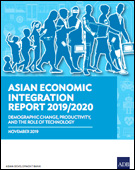 Asian Economic Integration Report 2019/2020: Demographic Change, Productivity, and the Role of TechnologyThis report reviews economic cooperation and integration in Asia and the Pacific. It reports that in 2018, the South Asia Subregional Economic Cooperation (SASEC) focused on reducing gaps in multimodal connectivity among its member countries. By the end of 2018, 52 ADB-financed projects worth $11.36 billion had been committed to SASEC projects, with an additional $106.44 million in 81 technical assistance grants. SASEC nodal officials and working groups met in Singapore in March 2018 to update the SASEC operational plan. The operational plan identified 77 projects ($45.6 billion) to be financed by SASEC members, ADB, and development partners. A holistic approach under the operational plan will build transport links with Southeast Asia and East Asia and expand regional trade markets. Author: Asian Development Bank Year: 2019 Download Tags: ADB, Regional Cooperation, SASEC, Trade Facilitation, Transport, Bangladesh, Bhutan, India, Maldives, Myanmar, Nepal, Sri Lanka Maritime Cooperation in SASEC: South Asia Subregional Economic CooperationMost South Asia Subregional Economic Cooperation (SASEC) countries rely on maritime transport for international trade. Stronger maritime relations are crucial to achieve the economic growth potential for the subregion. This report looks at how countries can strengthen international trade by improving maritime cooperation among the SASEC countries, comprised of Bangladesh, Bhutan, India, Maldives, Myanmar, Nepal, and Sri Lanka. It gives an overview of the SASEC maritime sector and identifies collaboration initiatives that could address key challenges. Author: Asian Development Bank Year: 2019 Download Tags: Transport, Trade Facilitation, Bangladesh, Bhutan, India, Maldives, Myanmar, Nepal, Sri Lanka, ADB RCI ADB Annual Report 2018The Asian Development Bank (ADB) supports cross-border infrastructure to help foster regional cooperation and integration. It is transforming transport corridors into economic corridors, allowing South Asian countries to participate in regional and global value chains and promote agriculture trade. In 2018, ADB committed $150 million to upgrade sections of South Asia Subregional Economic Cooperation (SASEC) road corridors in India and Nepal. The investments aim to improve connectivity between Manipur (in India) and Myanmar; build an India–Nepal international bridge; and improve the safety of Nepal’s East–West Highway. ADB also approved a technical assistance project to build institutional capacity and improve expertise of trade facilitation officials in SASEC member countries. Author: Asian Development Bank Year: 2019 Download Tags: Economic Corridor Development, ADB, Energy, India, Nepal, SASEC, Trade Facilitation SASEC Vision – MyanmarMyanmar serves as a land bridge between South Asia, Southeast Asia, and East Asia. This book identifies regional and subregional opportunities for Myanmar to harness natural and human resources, industrial potential, and infrastructure connectivity as part of the South Asia Subregional Economic Cooperation (SASEC) program. SASEC Vision – Myanmar serves to supplement the 2017 SASEC Vision document, which articulates shared aspirations of the SASEC countries and sets the path to achieve these through regional collaboration. Author: South Asia Subregional Economic Cooperation Program Year: 2019 Download Tags: SASEC, Trade Facilitation, Transport, Energy Doing Business 2019: Training for ReformA record 314 reforms were undertaken around the world, serving to improve business climate in the past year. South Asian economies carried out 19 reforms, many of which focused on improving starting a business, access to credit, paying taxes, and resolving insolvency. South Asia scored the highest for trading across borders. India continued its reform agenda and advanced 23 slots to 77th place in the global ranking, making it South Asia’s top-ranked economy. Bhutan introduced an online platform for filling corporate and personal income tax. Sri Lanka climbed to 100th place after instituting reforms on paying taxes and enforcing contracts. Author: World Bank Group Year: 2018 Download Tags: Ease of Doing Business, South Asia, Trade Facilitation, WB What Does It Cost to Trade Cross-Border?Customs duties, local taxes, and customs clearance increase trade costs and serve as obstacles for many small and medium enterprises. This paper explores challenges these enterprises face in using e-platforms and trading internationally. It looks at de minimis exemptions (the minimum value of goods below which no duties are collected) in India and other economies and analyzes the impact of these exemptions on exports by micro and small enterprises. Author: Sanjay Kumar Mangla Year: 2018 Download Tags: India, Trade Facilitation 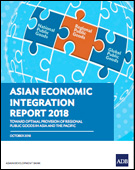 Asian Economic Integration Report 2018This report tracks the progress of regional cooperation and integration in Asia. It shows how intraregional trade grew in South Asia, Southeast Asia, and the Pacific. In South Asia, the South Asia Subregional Economic Cooperation (SASEC) has been focused on building multimodal connectivity to facilitate trade as one of its priorities. Its operational plan is being reviewed to better reflect regional project priorities in the region. SASEC is also studying how Myanmar, its newest member, is to be integrated as a vital link between South Asia, Southeast Asia, and East Asia. The chapter "Toward Optimal Provision of Regional Public Goods in Asia and the Pacific" looks at how collective action among countries can help find solutions for such transnational challenges as infrastructure connectivity, environmental degradation, and transnational health threats. Author: Asian Development Bank Year: 2018 Download Tags: ADB, Regional Cooperation, SASEC, Trade Facilitation East Asia Pacific Economic Update, April 2018: Enhancing PotentialEast Asia and Pacific (EAP) grew slightly faster than anticipated in 2017, with growth in Myanmar rebounding slightly at 6.4% due to strong exports. Amid risks to macroeconomic stability, EAP countries must enhance trade facilitation and integration, improve education systems, and upgrade capabilities of workers and managers. Author: World Bank Year: 2018 Download Tags: Exports, GDP, India, Manufacturing, Myanmar, Poverty Reduction, Trade Facilitation, WB Financing Infrastructure in Asia and the Pacific: Capturing Impacts and New SourcesThis book looks at the impact of infrastructure investment on economic and social indicators, and shows how infrastructure investment can increase output, taxes, trade, and firm productivity. One study in the book shows that trade facilitation reforms in South Asia resulted in increased intraregional trade and trade with other regions. The book proposes innovative modes of financing for infrastructure needed to drive sustainable growth. Author: Naoyuki Yoshino, Matthias Helble, and Umid Abidhadjaev (editors) Year: 2018 Download Tags: ADB, Infrastructure, Services, South Asia, Trade Facilitation Impact of Implementation of Digital Trade Facilitation on Trade CostsThis paper studies of the effect of the implementation of World Trade Agreement Trade Facilitation Agreement (WTO TFA) measures on trade costs in the Asia-Pacific region. Its analysis shows that full implementation of measures is associated with 15% reduction in trade cost. The paper also projects a 26% decrease in trade costs, amounting to $600 billion annually, with the full implementation of WTO TFA measures together with digital trade facilitation measures. It also looks at the need to develop legal and technical frameworks to support cross-border paperless trade, including the legal recognition of trade data and documents between public and private organizations in different countries. Author: Yann Duval, Chorthip Utoktham, and Alexey Kravchenko Year: 2018 Download Tags: Trade Facilitation, Trade Facilitation Agreement, WTO Services and Global Value Chains: The Asia-Pacific Reality, Studies in Trade, Investment and Innovation 89This book reviews issues concerning the roles of services in global value chains. It presents a framework for assessing links among different services and between services and the manufacturing sector. The book explains the contribution of services to global value chains in the Asia-Pacific region and to the world and also draws lessons with which countries could understand the importance of services and participation in global value chains to achieving sustainable development. Author: Witada Anukoonwattaka, Mia Mikic, Yuhua Zhang Year: 2017 Download Tags: ASEAN, Asia-Pacific, Energy, Global Value Chains, India, Nepal, Regional Cooperation, Sri Lanka, Sustainable Development, Sustainable Development Goals, Trade Facilitation, UNESCAP Trade and Trade Facilitation along the Belt and Road Initiative CorridorsThis paper reviews the current state of trade and trade facilitation among the countries along the six corridors under the Belt Road Initiative (BRI), and looks at the potential impact of infrastructure development on trade. It explores at the Bangladesh-China-India-Myanmar (BCIM) corridor, and reviews trade growth, tariff rates, logistics performance index, ease of trading across borders, and other indicators in those countries. Author: Bala Ramasamy, Matthew Yeung, Chorthip Utoktham, and Yann Duval Year: 2017 Download Tags: Bangladesh, Economic Corridor Development, India, Myanmar, Trade Facilitation Bangladesh: Company Perspectives – An ITC Series on Non-tariff MeasuresBangladesh exporters are burdened by various non-tariff measures, as well as regulatory and procedural obstacles to trade. They face long waiting times and administrative hurdles, which include difficulties involving border clearance and shipment inspection. This report recommends upgrading domestic infrastructure and streamlining procedures, enhancing enterprise competitiveness, and improving transparency in trade and trade facilitation. Author: International Trade Centre Year: 2017 Download Tags: Bangladesh, Trade Facilitation, Transparency 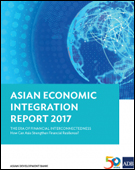 Asian Economic Integration Report 2017The 2017 Asian Economic Integration Report introduces the Asia-Pacific Regional Cooperation and Integration Index (ARCII), a composite index constructed from 26 socioeconomic indicators grouped into six dimensions: (i) trade and investment, (ii) money and finance, (iii) regional value chains, (iv) infrastructure and connectivity, (v) movement of people, and (vi) institutional and social integration. It helps capture the diversity of regional cooperation and integration, allowing Asian economies to keep track of their progress in regional integration. Within the region, ARCII shows RCI is highest in East Asia and Southeast Asia, but remains low in South Asia and Central Asia owing to gaps in infrastructure and connectivity. It is also low in the Pacific due to weak institutional and social integration. In subregional cooperation, SASEC comes third to the ASEAN and GMS. The publication highlights that regional integration can be improved through institutional and social dimensions, including efforts to remove national barriers to regional integration, adopt regional standards, and institutionalize regional frameworks, and narrowing gaps in regional connectivity and infrastructure. Author: Asian Development Bank Year: 2017 Download Tags: Regional Cooperation, Trade Facilitation, Connectivity, SASEC, GMS Regional Cooperation and Integration in Asia and the Pacific: Implementation of the Operational Plan for Regional Cooperation and Integration, 2016–2020─Corporate Progress Report 2017Regional cooperation and integration (RCI) is a valuable means for attaining national development goals. This report reviews ADB’s progress in implementing its Operational Plan for Regional Cooperation and Integration, 2016–2020, and identifies areas for improvement. It takes a close look at progress in connectivity, competitiveness, and regional public goods and collective action through projects such as the Nepal: SASEC Customs Reform and Modernization for Trade Facilitation Program. Author: Asian Development Bank Year: 2017 Download Tags: Nepal, Energy, Trade, Customs, Myanmar, Regional Cooperation, Regional Integration, SASEC, Trade Facilitation Customs Clearance Procedure for Relief Materials 2017 This relief consignment procedure published by the Nepal Department of Customs act as guide for the import of relief materials in response to emergencies and disaster situations in Nepal. It identifies items that can and cannot be imported, and conditions for import, and details procedures for Customs clearance, including declaration and valuation. It also discusses provisions for temporary import or export of relief goods. Author: Department of Customs, Ministry of Finance, Nepal Year: 2017 Download Tags: Customs, Nepal, Trade Facilitation, Temporary admission 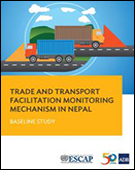 Trade and Transport Facilitation Monitoring Mechanism in NepalThis report synthesizes the business process analysis conducted on import of wool through Kolkata-Birgunj-Kathmandu, export of wool carpet from Kathmandu-Birgunj-Kolkata, and import of fabrics from Bangladesh to Nepal through Dhaka-Banglabandha-Fulbari-Panitanki-Kakarbhitta-Kathmandu. It also measures the performance of trade corridors and border crossings in Nepal, to quantify current trade and transport facilitation and provide recommendations. Findings of the study reveal bottlenecks to trade, including procedures needed to complete import/export, compounded by requirements for transiting trade through India, which further prolongs the trade process and increases the cost. The report includes specific short-term and long-term policies to improve Nepal’s trade and transport facilitation. Author: Asian Development Bank and United Nations Economic and Social Commission for Asia and the Pacific Year: 2017 Download Tags: Trade Facilitation, Nepal, Import, Export, ADB RCI 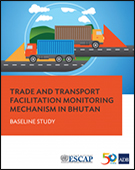 Trade and Transport Facilitation Monitoring Mechanism: Baseline Study in BhutanThis report synthesizes the business process analysis conducted on import of light motor vehicles from third countries to Bhutan via Kolkata Port, import of plastic kitchenware and tableware (melamine products) from Bangladesh to Bhutan, export of ferrosilicon from Bhutan to third countries through Kolkata Port, and export of cardamom from Bhutan to Bangladesh. It also measures the performance of trade corridors and border crossings in Bhutan, to quantify current trade and transport facilitation and provide recommendations. Findings of the study reveal bottlenecks to trade, including numerous procedures needed to complete import/export, and low speed along the trade corridors. The report includes specific short-term and long-term policies to improve Bhutan’s trade and transport facilitation. Author: Asian Development Bank and United Nations Economic and Social Commission for Asia and the Pacific Year: 2017 Download Tags: Bhutan, Trade Facilitation, Bangladesh, ADB, Transport, ADB RCI 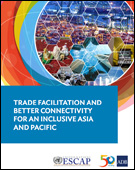 Trade Facilitation and Better Connectivity for an Inclusive Asia and PacificThis report investigates the evolution of trade costs, examines trade facilitation and paperless trade implementation, and highlights key initiatives in South Asia, including efforts by members of the South Asia Subregional Economic Cooperation (SASEC). The SASEC Trade Facilitation and Transport Working Group agreed to expand assistance to trade facilitation through technical assistance to support more efficient, transparent, secure, and service-oriented processing of cross-border trade across South Asia. Through 2025, the SASEC connectivity agenda will be better aligned with the frameworks of South Asian Association for Regional Cooperation and the Bengal Initiative for Multi-Sectoral Technical and Economic Cooperation. To help establish a trade and transport facilitation monitoring mechanism, Bangladesh, Bhutan, and Nepal conducted studies that reviewed trade and transport procedures, analyzed bottlenecks, and gave recommendations on trade and transport facilitation. Author: Asian Development Bank and United Nations Economic and Social Commission for Asia and the Pacific Year: 2017 Download Tags: ADB, Bangladesh, Bhutan, BIMSTEC, Maldives, Nepal, SAARC, India, Myanmar, SASEC, South Asia, Sri Lanka, Trade Facilitation, Transport, UNESCAP, ADB RCI 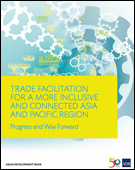 Trade Facilitation for a More Inclusive and Connected Asia and Pacific Region: Progress and Way ForwardThis report gives an overview of assessments from the 2017 global survey on trade facilitation and paperless trade in Asia and the Pacific. It looks at the implementation of trade facilitation and paperless trade measures in 44 countries in Asia and the Pacific, including how the South Asia Subregional Economic Cooperation Trade Facilitation Strategic Framework promotes development by deepening regional cooperation. The Framework covers national and subregional projects in Customs harmonization, improving cross-border facilities, and transport facilitation. The Framework also supports regulatory reforms and the development of the National Single Window Customs management system in Bangladesh, Bhutan, Maldives, and Nepal. Author: Asian Development Bank and United Nations Economic and Social Commission for Asia and the Pacific Year: 2017 Download Tags: ADB, Bangladesh, Bhutan, BIMSTEC, Maldives, Nepal, Regional Cooperation, Regional Integration, SAARC, SASEC, Standards Harmonization, Trade Facilitation, Trade Facilitation Agreement, WTO, UNESCAP, ADB RCI 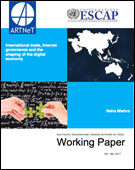 International Trade, Internet Governance and the Shaping of the Digital Economy (AWP No. 168)The connection between trade and internet governance presents complex policy challenges in today’s digital economy. This working paper highlights several observations and findings on the complex relationship between international trade and the internet. It recognizes the fact that the internet is not only driven by economic factors, but is a complex phenomenon shaped by political and social engagement, technical efficiency, and cultural and moral considerations. It sees the importance of synergizing international trade and the internet, and recommends that the World Trade Organization and other trade institutions develop mechanisms to consult internet governance institutions such as the Internet Engineering Task Force, World Web Wide Consortium, Internet Corporation for Assigned Names and Numbers, International Telecommunications Union, Internet Society, and the Internet Governance Forum. Author: Neha Mishra Year: 2017 Download Tags: ICT, Trade Facilitation, UNESCAP, WTO World Trade Statistical Review 2017The World Trade Statistical Review looks at the last 10 years and examines the latest developments in world trade, with a detailed analysis of the most recent trends for trade in goods and services. The book gives information on the participation of India, Bangladesh, and other South Asian economies in world trade, and highlights trends in the use of trade-facilitating measures. It also gives information on the implementation of the WTO Trade Facilitation Agreement and regional trade agreements, such as the South Asian Free Trade Arrangement. Author: World Trade Organization Year: 2017 Download Tags: Export, Least Developed Countries, Aid for Trade, SAFTA, South Asia, Trade Facilitation, WTO, Bangladesh, Bhutan, India, Maldives, Myanmar, Nepal, Sri Lanka Trade and Transport Facilitation Monitoring Mechanism: Baseline Study in BangladeshThis report synthesizes the business process analysis conducted on the export of plastic kitchenware and tableware from Bangladesh to Bhutan through Burimari land port, and the import of lentils from Nepal to Bangladesh through Banglabandha land port, as well as studies on trade corridors and border crossings in Bangladesh, to quantify current trade and transport facilitation in Bangladesh through a set of indicators. Findings of the study reveal bottlenecks to trade, including costly one-time procedures for a new trader, numerous documents and copies required to complete export and import processes, and low speed along the trade corridors. This report includes specific short-term and long-term policies to improve Bangladesh’s trade and transport facilitation. Author: Asian Development Bank Year: 2017 Download Tags: Trade Facilitation, Transport, Bhutan, Bangladesh, Nepal, SASEC, ADB RCI 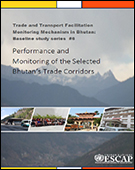 Performance and Monitoring of Selected Bhutan’s Trade CorridorsThis report on performance and monitoring of two corridors, the Kolkata-Phuentsholing corridor and the Burimari-Phuentsholing corridor is the sixth of a six-part study on Trade and Transport Facilitation Monitoring Mechanism (TTFMM) in Bhutan. The study finds that average speed along the corridor is very low. Along the Kolkata-Phuentsholing corridor, average speed with delays is 9 kilometers per hour (km/h) and without delays is 15 km/h. Along the Burimari-Phuentsholing corridor, average speed with delays is about 5 km/h and without delays is 16 km/h. The challenges to ensuring efficient transport along the corridor remain significant, yet the study sees tremendous opportunities for improvement, and raises the importance of continuous and effective monitoring to observe whether trade and transport performance along the corridor improve over time. Author: United Nations Economic and Social Commission for Asia and the Pacific Year: 2017 Download Tags: UNESCAP, Bhutan, Trade Facilitation, Transport Time Release Study in PhuentsholingThis Time Release Study report undertaken at Phuentsholing Land Border Crossing Station in Bhutan is the fifth of a six-part study on Trade and Transport Facilitation Monitoring Mechanism (TTFMM) in Bhutan. According to the study, the average time taken for clearance of import goods from India is 58 minutes for taxable goods and 28 minutes for non-taxable/exempted goods. Imports from third countries take around 16 hours for taxable goods and 7 hours for non-taxable/exempted goods. Export of goods to India and third countries follow the same procedure, with around 13 minutes on the average needed to clear export goods. Specific recommendations are given to further enhance the efficiency of clearance of goods at the borders, including conducting the TRS on a regular basis. Author: United Nations Economic and Social Commission for Asia and the Pacific Year: 2017 Download Tags: UNESCAP, Trade Facilitation, Bhutan Business Process Analysis of Export of Ferro Silicon from Bhutan to the Third CountriesThis business process analysis report on the export of Cardamom from Bhutan to Bangladesh via Phuentsholing-Jaigaon-Changrabandha-Burimari is the fourth of a six-part study on Trade and Transport Facilitation Monitoring Mechanism (TTFMM) in Bhutan. According to the study, it takes 29 days to complete all export procedures for new traders. The process is reduced to 26.5 days without the first time procedures. Total cost to export a typical truckload of two metric tons of cardamom is around $654, with one-time procedures amounting around $308. 24 documents are needed to complete the export process, with some documents requiring extra copies, numbering to as much as 71. Specific recommendations are given to improve trade in this commodity. Author: United Nations Economic and Social Commission for Asia and the Pacific Year: 2017 Download Tags: Bangladesh, Bhutan, Trade Facilitation, Transport Business Process Analysis of Import of Light Motor Vehicles from the Third Countries to Bhutan via Kolkata PortThis business process analysis report on the import of light motor vehicles (LMVs) from third countries to Bhutan via Kolkata Port is the first report of a series of a six-part study on Trade and Transport Facilitation Monitoring Mechanism (TTFMM) in Bhutan. Study findings reveal it takes 28.5 days to import LMVs from the Republic of Korea, with costs amounting to around $1,289 to complete the import procedures, not including the applicable duty and taxes payable in Bhutan. 39 documents are needed to complete the import process, with 12 documents requiring extra copies. Specific recommendations are given to improve trade in this commodity. Author: United Nations Economic and Social Commission for Asia and the Pacific Year: 2017 Download Tags: UNESCAP, Bhutan, Trade Facilitation, Transport Digital Trade Facilitation: Paperless Trade in Regional Trade AgreementsMost regional trade agreements now feature one or more measures for electronically exchanging trade-related information. These measures are becoming essential to maintaining trade competitiveness and enabling effective participation in cross-border e-commerce. This paper examines the extent to which measures enabling paperless trade are included in regional trade agreements (RTAs), such as the Association of Southeast Asian Nations-India Free Trade Agreement. India leads the region with the highest number of RTAs involving paperless trade measures. Asia-Pacific RTAs now increasingly cover specific areas of paperless trade such as electronic certificates of origin and sanitary and phytosanitary certificates. Author: Yann Duval and Kong Mengjing Year: 2017 Download Tags: ADB, ASEAN, Free Trade Agreements, India, Regional Cooperation, Trade Facilitation, UNESCAP, WTO 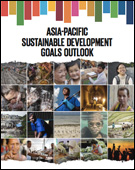 Asia-Pacific Sustainable Development Goals OutlookThis outlook report on the Sustainable Development Goals (SDG) offers an overview of the issues confronting the Asia and the Pacific region in eradicating poverty. Calling for greater synergies and collaboration, this report underscores that climate change and growth policies, including initiatives to improve access to energy and other forms of infrastructure, must also correspond to poverty-reduction strategies. The first knowledge product under a renewed partnership between the Economic and Social Commission for Asia and the Pacific, the Asian Development Bank, and the United Nations Development Programme, this report brings together experts and practitioners in the hope of inspiring new ideas to achieve the 2030 agenda. Author: United Nations Economic and Social Commission for Asia and the Pacific, Asian Development Bank, and United Nations Development Programme Year: 2017 Download Tags: Regional Cooperation, Trade Facilitation, Poverty Reduction, South Asia Basic Statistics 2017Basic Statistics 2017 contains development indicators for 45 economies in the Asia and Pacific Region, including the seven SASEC countries, Bangladesh, Bhutan, India, Maldives, Myanmar, Nepal, and Sri Lanka. It includes selected indicators of the Sustainable Development Goals (SDGs) such as the proportion of population living below $1.90 (PPP) a day, proportion of population with access to electricity, renewable energy share in the total final energy consumption, unemployment rate, total official flows for infrastructure, and trade balance. Author: Asian Development Bank Year: 2017 Download Tags: Energy, Trade Facilitation, Transport, Sustainable Development Goals, Bangladesh, Bhutan, India, Maldives, Myanmar, Nepal, Sri Lanka SASEC Powering Asia in the 21st Century SASEC Powering Asia in the 21st Century defines the SASEC Vision, framing the SASEC partnership in the larger context of the subregion’s collective growth and development by articulating shared aspirations of the SASEC countries (Bangladesh, Bhutan, India, Maldives, Myanmar, Nepal, and Sri Lanka), and setting the path to achieve these through regional collaboration. The SASEC Vision lays out a subregional transformative opportunity by leveraging natural resources, promoting industry linkages for the development of regional value chains, and expanding the region’s trade and commerce through the development of subregional gateways and hubs. This document is supplemented by SASEC Vision – Myanmar. Author: South Asia Subregional Economic Cooperation Year: 2017 Download Tags: SASEC, Trade Facilitation, Transport, Energy, ADB RCI 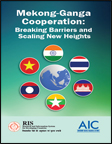 Mekong-Ganga Cooperation: Breaking Barriers and Scaling New HeightsThe Mekong-Ganga Cooperation (MGC) promotes intra-regional collaboration among Cambodia, India, Lao PDR, Myanmar, Thailand and Vietnam in the areas of trade, tourism, culture, education, and transport and communications. This book reviews how MGC cooperation has grown since MGC's inception in 2000, including expansion of their economic and cultural relations. Under India's Act East Policy, MGC has gained further momentum – endorsing a Plan of Action 2016-2018, and planning extended connectivity of the India-Myanmar-Thailand Trilateral Highway to Cambodia, Laos, and Vietnam. This report outlines important discussion points on trade, regional value chains, foreign direct investment, physical and digital connectivity, border connectivity, and cultural relations, to strengthen India and the Association of Southeast Asian Nation linkages through MGC. Author: Research and Information System for Developing Countries and ASEAN-India Centre Year: 2017 Download Tags: ASEAN, India, Southeast Asia, South Asia, Trade, Trade Facilitation Trade and the Post-2015 Development AgendaTrade and services are instrumental in achieving the Sustainable Development Goals. While openness to trade improves economic growth prospects, sound trade policy and efforts to reduce the costs of trade are necessary to bridge the link between trade growth and poverty reduction. For low income countries, there is still great scope to leverage trade for development, and pursue better access to a products and services to improve welfare, which can significantly contribute to economic development. In keeping with the post-2015 development agenda, this paper recommends sustained efforts by governments to reduce trade costs, support policy reforms to improve services trade, and focus on trade cost reduction and services trade facilitation. Author: Bernard Hoekman Year: 2017 Download Tags: Trade Facilitation, Services, Sustainable Development, Poverty Reduction, ADB Facilitate Trade for Development: Aid for Trade The Aid for Trade program has been providing support to developing economies in tackling obstacles to growth through better facilitation of trade in the last 10 years. Since its launch in 2006, a total of $308 billion has been disbursed to finance aid-for-trade programs and projects, which are working to reduce trade and transport costs, promote trade expansion, and achieve economic and social objectives. As high trade costs persist in keeping developing countries from fully exploiting their trade and development potential, the Aid for Trade program remains highly relevant, and will help developing economies, including landlocked and small and vulnerable economies, achieve the 2030 Agenda for Sustainable Development. Author: William Hynes and Frans Lammersen Year: 2017 Download Tags: Trade, Development, Aid for Trade, Trade Facilitation, Transport, Bangladesh, Bhutan, Myanmar, Nepal, Least Developed Countries 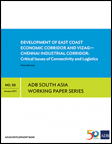 Development of East Coast Economic Corridor and Vizag-Chennai Industrial CorridorThe East Coast Economic Corridor (ECEC)—India’s first coastal corridor—is an integrated economic development initiative that is expected to help pursue industrialization and integrate domestic companies into the global value chains of Southeast Asia and East Asia. Its development will start with Vizag–Chennai Industrial Corridor (VCIC), which covers about 800 kilometers and includes several ports and major industrial centers. This paper discusses strategies to consider when trying to improve shipping and air connectivity in the ECEC and Vizag–Chennai Industrial Corridor (VCIC). It stresses the importance of infrastructure development and regulatory reforms that facilitate increased connectivity. Author: Pritam Banerjee Year: 2017 Download Tags: Bangladesh, Connectivity, Economic Corridor, India, Infrastructure, Regional Integration, Trade Facilitation, Transport, Development, Economic Corridor Development, ADB RCI 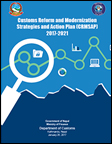 Customs Reform and Modernization Strategies and Action Plan 2017-2021The Customs Reform and Modernization Strategies and Action Plan 2017-2021 of the Nepal Department of Customs (DOC) aims to serve as a blueprint of Customs reform for the next four years, with a vision to support Nepal's initiatives toward economic and social prosperity. With Nepal seeing continuous increase of cross-border trade over the last decades, this Plan is being implemented to align Nepal toward international standards. It outlines the DOC's vision, mission, guiding principles, as well as strategies, such as expediting legitimate trade facilitation and enhancing Customs automation and data management, to create a conducive environment for seamless movement of cargo traffic to and from the borders, and help in lowering transaction costs through greater transport facilitation. Author: Nepal Department of Customs Year: 2017 Download Tags: Customs, Customs Valuation, Nepal, Trade Facilitation, Import, Export, Trade, Revised Kyoto Convention 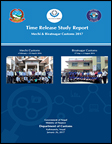 Time Release Study: Mechi and Biratnagar Customs 2017Time Release Study is a special tool developed by the World Customs Organization to measure effectiveness of operational procedures carried out by Customs, other regulatory agencies and private sector stakeholders in the standard processing of imports, exports, cross border and transit movements. A key activity identified in Nepal's Customs Reform and Modernization Strategies and Action Plan 2013-2017, it identifies the average time taken for clearance of consignments from entry to exit in the Customs area, enabling possible corrective measures to
improve performance. This Study was undertaken to support trade facilitation measures being introduced by the Nepal Department of Customs to reduce bottlenecks to faster Customs clearance, and promote seamless movement of cargo traffic to and from the Country. Author: Nepal Department of Customs TRS Working Group Year: 2017 Download Tags: Trade Facilitation, Time Release Study, Import, Export, Trade, Nepal, WCO 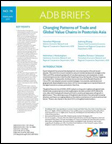 Changing Patterns of Trade and Global Value Chains in Postcrisis AsiaThis Asian Development Bank brief examines how patterns of trade and global value chains (GVCs) in developing Asia have changed since the global financial crisis. The paper reports that export slowdown in the region was caused by a combination of weak import demand for Asian goods in advanced economy markets, structural transformation and reduced import demand in the People’s Republic of China, and possible impact of increasing non-tariff measures. According to this paper, it further states that much of the weak import demand is likely
to be temporary — developing Asia gained a 1.5% increase in exports in 2016, after a 0.8% decline in 2015. Among South Asian economies, India and Sri Lanka are expected to have better export volume growth in 2016. Author: Ganeshan Wignaraja, Juzhong Zhuang, Mahinthan J. Mariasingham, and Madeline Dumaua-Cabauatan Year: 2017 Download Tags: Global Value Chains, Import, Export, India, Sri Lanka, Non-Tariff Measures, Trade Facilitation Time, Uncertainty, and Trade FlowsThis paper assesses the impact of international transit time and time-related uncertainty on bilateral trade, including their impact on trade costs. It concludes that international transit time matters primarily for South-South trade, while uncertainty is more important for North-North trade. Both factors are confirmed to be statistically and economically significant determinants of bilateral trade, including global value chains, and strengthens the ground on the emerging policy emphasis to address the overall costs faced by supply chain operators, including costs linked to uncertainty. Author: Jose Anson, Jean-Francois Arvis, Mauro Boffa, Matthias Helble, and Benjamin Shepherd Year: 2017 Download Tags: Trade, Trade Facilitation, Transport, South-South Trade Accumulating Trade Costs and Competitiveness in Global Value ChainsThis paper examines the implications of trade costs, including applied tariffs, transportation and insurance costs, on competitiveness at industry, national and global levels, and identifies where trade facilitation investment would have the highest social returns from the perspective of global value chains (GVCs). With trade costs amplified along GVCs, profitability of individual business operations are affected by incurred transaction expenses. The authors conclude that direct benefits of trade facilitation will be higher for countries that are not yet well integrated into international trade, but key traders who are at the core of GVCs also stand to gain much. Author: Antonia Diakantoni, Hubert Escaith, Michael Roberts and Thomas Verbeet Year: 2017 Download Tags: Trade, Tariff, Transport, Trade Facilitation, Global Value Chains Doing Business 2017: Equal Opportunity for AllGovernments including that of India have relied on Doing Business to provide insights into good practices worldwide. Doing Business 2017: Equal Opportunity for All presents quantitative indicators on business regulations that can be compared across 190 economies. It shows how South Asia can work to improve certain areas, including removing restrictions on women’s right to work. It also shows how South Asia has been the most successful region in terms of trading across borders. Bhutan, with a global ranking of 73, ranks highest among South Asian countries. Author: World Bank Group Year: 2017 Download Tags: Trade Facilitation, Ease of Doing Business, Transport, WB World Tariff Profiles 2016World Tariff Profiles, a joint publication of the World Trade Organization (WTO), International Trade Centre, and the United Nations Conference on Trade and Development, provides comprehensive information on tariff parameters imposed by the 164 WTO members—including Bangladesh, India, Maldives, Myanmar, Nepal, and Sri Lanka— and other countries and Customs territories with available data on imports—including Bhutan, a WTO Observer. It contains individual country tariff profiles, and statistics on non-tariff measures in effect as of December 2015. This 2016 edition also contains a discussion of the 2017 Harmonized System, which will affect around 15% of goods traded globally. Author: World Trade Organization, International Trade Centre, and the United Nations Conference on Trade and Development Year: 2016 Download Tags: Tariff, Trade Facilitation, Customs Paperless Trade in Regional Trade AgreementsThis working paper provides a comprehensive list of paperless trade measures in regional trade agreements, which have become more extensive, covering increasingly specific areas including certificate of origins and sanitary and phytosanitary certificates. It also confirms that the number of paperless trade measures have doubled between 2005-2008 and 2013-2016 at the global level, with regional trade containing more provisions than those featured in the World Trade Organization's Trade Facilitation Agreement. It introduces the new United Nations Treaty and Framework Agreement on Cross-Border Paperless Trade in Asia and the Pacific, which aims to become a tool for harmonized implementation of paperless trade provisions. Author: Yann Duval and Kong Mengjing Year: 2016 Download Tags: Paperless Trade, Sanitary and Phytosanitary Measures, Trade Facilitation, India Trade Facilitation and Global Value Chains: Opportunities for Sustainable DevelopmentThis paper analyzes the relationship between global value chains (GVCs) and trade facilitation, and its contribution to sustainable development outcomes on low-income and least developed countries (LICs and LDCs). A key insight of the paper concludes that it is not fundamentally GVCs that drive the sustainable development implications of improved trade facilitation, but the resulting extension and intensification of economic activity. It underlines the importance of putting in place domestic regulatory infrastructure that considers the appropriate economic, social, and environmental dimensions to ensure that GVCs remain consistent with the global commitment to sustainable development, while expanding economic opportunities of LICs and LDCs. Author: Ben Shepherd Year: 2016 Download Tags: Trade Facilitation, Trade, Global Value Chains, Sustainability, Sustainable Development, Least Developed Countries, LDC 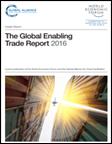 Global Enabling Trade Report 2016The Global Enabling Trade Report has been created to provide insight into trade policy and practice. It includes the Enabling Trade Index (ETI), which assesses the extent to which economies have in place institutions, policies, infrastructures and services facilitating the free flow of goods over borders and to their destination. This edition highlights that while an increasingly globalized trading system has been lifting millions out of poverty, trade barriers and costs are still preventing millions of people around the world from engaging in international trade. It reports that all South Asian economies have improved their ETI score over the past two years, with Bhutan as the most improved country in the region, jumping 12 places to 92, followed by India at 102, Sri Lanka at 103, Nepal at 108, Pakistan at 122, and Bangladesh at 123, yet the region remains the most closed worldwide. While South Asia has improved its access to foreign markets and adoption of ICTs, it needs to improve access to its domestic market – on average, South Asian countries impose a tariff of 16.7% on imported products – and enhance its transport infrastructure, particularly in Bhutan and Nepal. Author: Global Alliance for Trade Facilitation and the World Economic Forum Year: 2016 Download Tags: Trade, Trade Facilitation, Transport, Trade Policy, World Economic Forum, Bangladesh, Bhutan, India, Sri Lanka, Pakistan 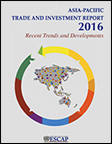 Asia-Pacific Trade and Investment Report 2016: Recent Trends and DevelopmentsThe Asia-Pacific Trade and Investment Report 2016 reports that the Asia-Pacific region is still the largest exporter of goods globally, with a share of 40%. Its share in commercial services trade is also on the rise, while restrictiveness of services trade has not increased. Foreign direct investment (FDI) inflows is also growing at a much faster pace compared to the global average, with special economic zones being used as one of the modalities to attract FDI. India, in particular, has been attracting an increasing portion of FDI inflows, both from outside and inside the region. While economies in Asia and the Pacific continue to make progress toward trade facilitation, there are still huge gaps among subregional economies, with much needing to be done to reduce trade costs. Furthermore, efforts undertaken to reduce trade costs through trade facilitation have been partially offset by imposition of a large number of new trade distortive measures globally and regionally, with most of these new measures falling under the non-tariff category. Author: United Nations Economic and Social Commission for Asia and the Pacific Year: 2016 Download Tags: Export, Trade Facilitation, Non-Tariff Measures, FDI, South Asia, India, Special Economic Zones Research Handbook on Trade in ServicesThis Research Handbook explores the latest developments in services trade by drawing on insights from experts with a range of perspectives, including empirical economics, law and global political economy. The book further chronicles the rising stakes and involvement of developing countries in global services trade, notably their growing insertion in global value chains, as well as the latest advances and remaining challenges in the statistical measurement of trade in services. Author: Pierre Sauvé and Martin Roy, editors Year: 2016 Download Tags: Services, Trade, Economics, Trade Facilitation, Trade Policy 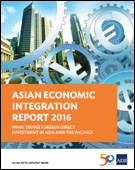 Asian Economic Integration Report 2016: What Drives Foreign Direct Investment in Asia and the Pacific?The 2016 Asian Economic Integration Report reviews regional economic cooperation and integration in Asia and the Pacific, amidst the rising global uncertainty following the United Kingdom’s referendum on leaving the European Union and the U.S. election, slower-than-expected global economic recovery, and ongoing economic restructuring in the People’s Republic of China and growth moderation. Asia faces heightened uncertainty–trade growth decelerated in 2015, falling to 2.3% in 2015; subregional trade linkages continue to strengthen, but inter-subregional trade linkages weakened; and non-tariff measures have become major obstacles to trade. In South Asia, SASEC cooperation has improved access to key markets in smaller economies, reduced real trade costs and behind-the-border barriers to stimulate investment; and enabled cross-border power exchanges to ensure power supply affordability, reliability, and overall grid stability. However, the SASEC agenda needs to be framed within wider integration processes taking place in Asia in the next decade to enhance economic linkages, and harness the full potential of Asian integration. Author: Asian Development Bank Year: 2016 Download Tags: ADB, ASEAN, Asia-Pacific, Development, FDI, Free Trade Agreements, Regional Cooperation, Regional Integration, SASEC, Trade Facilitation, UNCTAD, Bangladesh, Bhutan, India, Maldives, Nepal, Sri Lanka Connecting Bangladesh: Economic Corridor NetworkEconomic corridors anchored on transport connectivity could significantly boost Bangladesh's economic growth. This paper presents a new set of corridors for Bangladesh – a nine-corridor comprehensive integrated multimodal economic corridor network that will enhance Bangladesh’s role as land bridge between South Asia and Southeast Asia, and between South Asia and northern Asia. These proposed corridors are designed to sustain robust economic growth over the long term by improving regional connectivity, transit, and integration, alongside trade facilitation measures. Author: Mohuiddin Alamgir Year: 2016 Download Tags: Economic Corridor, Bangladesh, South Asia, Southeast Asia, Connectivity, Transport, Trade Facilitation, ADB RCI Implementing the Trade Facilitation Agreement: From Vision to RealityLow income to upper-middle income countries stand to gain a 14.6% to 16.5% reduction in trade costs upon implementation of the World Trade Organization's (WTO) Trade Facilitation Agreement (TFA). This publication looks at progression of the TFA – from conclusion of the talks at the 2013 Bali Ministerial Conference to preparations for the Agreement to take effect, as the valedictory moment of the TFA's entry into force nears. It highlights milestones, discusses the state of the ratification process, reviews implementation schedules, and examines work still to be done. Author: Nora Neufeld Year: 2016 Download Tags: Trade Facilitation, WTO, Least Developed Countries, Import, Export Trade Costs and Inclusive Growth: Case Studies Presented by WTO Chair-holdersThese contributions from participants of the World Trade Organization (WTO) Chairs Programme—which supports trade-related activities by academic institutions in developing countries—offer insightful research on opportunities that open up for developing countries when trade costs are reduced. Analyzing the potential impact of the WTO Trade Facilitation Agreement implementation in various developing regions of the world, this publication offers detailed country-level analysis on benefits of trade facilitation, including export diversification, greater global value chain participation, insertion of SMEs into international trade, the attraction of more foreign direct investments, and better governance. Author: Robert Teh, Maarten Smeets, Mustapha Sadni Jallab and Fatima Chaudhri, editors Year: 2016 Download Tags: Trade Facilitation, Global Value Chains, Small and medium enterprises, FDI, Governance, WTO 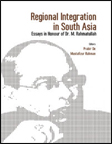 Regional Integration in South Asia: Essays in Honour of Dr. M. RahmatullahBuilding efficient transport linkages within and across countries in South Asia is crucial to development of production networks and value chains, and promotion of trade and investment. This collection of essays honors Dr. M. Rahmatullah, who championed the cause of multimodal connectivity in South Asia for seamless movement of goods across Asia, and dreamt of building an integrated South Asia through corridors and gateways to be connected with pan-Asian transport networks. A valuable resource for policymakers, academics, and practitioners working on issues of South Asian regional integration, this book looks at progress made on facilitating trade and enhancing connectivity in the region, assesses policy priorities, implementation imperatives, and emerging challenges to South Asian trade and integration, and gives recommendations on further strengthening South Asian integration. Author: Prabir De and Mustafizur Rahmant Year: 2016 Download Tags: Transport, Trade, Trade Facilitation, Connectivity, South Asia, South Asian Economic Union Reducing Trade Costs in LDCs: The Role of Aid for TradeThis report analyzes the role of Aid for Trade in reducing trade costs in least developed countries (LDCs), where trade costs are high and constitute a major impediment to the countries' participation in international trade. The most important sources of trade costs in LDCs are inadequate transport infrastructure, cumbersome border procedures, and compliance with non-tariff measures for merchandise exports. The study covers countries from around the world, including trade facilitation and trade restrictions in Nepal, Bhutan, India, and other Asian countries. Author: Rainer Lanz, Michael Roberts, Sainabou Taal Year: 2016 Download Tags: Trade, Trade Facilitation 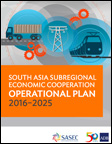 South Asia Subregional Economic Cooperation Operational Plan 2016-2025The SASEC Operational Plan 2016–2025 embodies the strategic objectives and operational priorities of the SASEC Program for the next decade. It expands the SASEC Program's focus beyond intraregional cooperation to developing links with Southeast and East Asia, thus widening the scope of transport, trade facilitation, and energy cooperation. Economic and industrial corridor development, which will arise from improved connectivity, has been introduced as a priority initiative. SASEC 2025 is supported by a list of potential projects to be implemented in the subregion during 2016-2025, that will advance the SASEC goals of multi-modal connectivity, energy security and the growth of regional energy markets, and increased intra- and inter-regional trade. An
update to the operational plan was
published in 2020. Author: Asian Development Bank Year: 2016 Download Tags: SASEC, ADB, Trade Facilitation, Economic Corridor, Transport, Myanmar 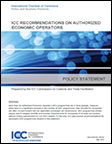 ICC Recommendations on Authorized Economic OperatorsThe World Customs Organization (WCO) developed the WCO Framework of Standards to Secure and Facilitate Global Trade (SAFE), of which the Authorized Economic Operator (AEO) program is an integral part, referring to manufacturers, importers, exporters, brokers, carriers, consolidators, intermediaries, ports, airports, terminal operators, integrated operators, warehouses, distributors, and others that have been approved by or on behalf of a national Customs administration as complying with WCO or equivalent supply chain security standards. AEO accreditation provides several benefits, including immediate release procedures self-assessment, and relief from guarantee/bond requirements. With AEO programs globally on the rise, the International Chamber of Commerce has put together several recommendations for successful AEO programs that lead to tangible benefits and process improvements for companies of all sizes and sectors, without limiting opportunities for non-AEO traders. Author: ICC Commission on Customs and Trade Facilitation Year: 2016 Download Tags: Customs, Trade Facilitation, WCO 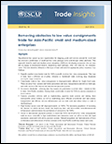 Removing Obstacles to Low Value Consignments (Trade Insights: Issue No. 18)Diffusion of digital technology and digitalization of products and services are allowing developing country small and medium-sized enterprises (SMEs)—which generate the majority of employment, especially in landlocked developing countries such as Nepal—to become globally competitive and participate in international trade. However, several barriers continue to hinder developing country SMEs to maximize benefits of cross-border digital trade. This publication recommends critical actions, including raising de-minimis thresholds; reducing Customs document requirements; developing low-cost and efficient transportation, delivery services, telecommunications and broadband networks; and establishing a legal framework that enhances conduct of online transactions. Additionally, neighbors in the region must coordinate and work together to build the required infrastructure, and to allow for mutual recognition or harmonization of systems, procedures, enforcement mechanisms and laws affecting digital trade. Author: Pascale Bourquin and Adam Heal Year: 2016 Download Tags: Small and Medium Enterprise, Nepal, ICT, Customs, Trade Facilitation SARSO News Volume 2, Issue 2The South Asian Regional Standards Organization (SARSO) newsletter features updates on SARSO events and activities. This issue highlights initiatives by SARSO to harmonize standards and improve conformity assessment in the region through workshops, and also meetings of its sectoral technical committees. It also discusses the Cooperation Agreement signed by SARSO and the International Organization for Standardization, to help facilitate the flow of goods and services, and participation of SARSO in a meeting organized by the private sector on 'Promoting Trade in Bangladesh-Bhutan-India-Nepal' region. Author: South Asian Regional Standards Organization Year: 2016 Download Tags: Standards, Trade Facilitation, SAARC, BBIN, South Asia 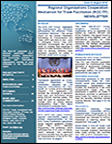 Regional Organizations Cooperation Mechanism for Trade Facilitation (ROC-TF) Newsletter: Issue X, August 2016This issue highlights the framework agreement on cross-border paperless trade facilitation adopted by the United Nations Regional Commission for Asia-Pacific, which will facilitate the exchange of electronic trade data and documents between participating United Nations Economic and Social Commission for Asia and the Pacific (UNESCAP) member states, and the 2016 Global Facilitation Partnership for Transportation and Trade forum. The latterencourages the private sector to mobilize expertise in support of trade facilitation reforms to develop effective trade facilitation solutions for small and medium-sized enterprises. The Newsletter also features SASEC-supported initiatives, including the launch of the new Maldives Customs Service training module on Customs valuation, as well as data collection for establishing the Trade and Transport Facilitation Monitoring baseline in Bhutan. The ROC-TF newsletter is a biannual publication featuring updates, publications and forthcoming activities of regional and international organizations working on trade facilitation in the Asia-Pacific region, including the Asian Development Bank, the World Customs Organization, and UNESCAP. Author: United Nations Economic and Social Commission for Asia and the Pacific Year: 2016 Download Tags: Trade Facilitation, ICT, Maldives, Customs, SASEC, Customs Valuation, Bhutan 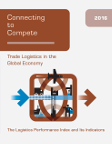 Connecting to CompeteConnecting to Compete scores and benchmarks countries’ performance on logistics, which is determined by various factors including infrastructure, regulations, policies, geography, and political economy. In the 2016 Logistics Performance Index (LPI), which measures the efficiency of international supply chains, the “logistics gap” between more and less developed countries remain evident. Among SASEC member countries, India is a top performing lower-middle-income economy, improving its rank from 54 in 2014 to 35 in 2016. Bangladesh is ranked 87, Maldives is ranked 104, Nepal is ranked 124, and Bhutan is ranked 135. The publication remarks that coastal countries score better than landlocked countries—a pattern clearly evident in South Asia—and notes that lack of integration in the region keeps the good logistics performance of India from improving the rankings of its neighbors. For countries at the bottom of the rankings, border management reforms continue to be a serious concern, as paperwork and long delays constrain trade efficiency. Author: Jean-François Arvis, Daniel Saslavsky, Lauri Ojala, Ben Shepherd, Christina Busch, Anasuya Raj, and Tapio Naula Year: 2016 Download Tags: Logistics, Business Efficiency, Trade Facilitation 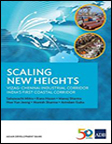 Scaling New Heights: Vizag-Chennai Industrial Corridor, India’s First Coastal CorridorThis book provides policymakers with a guide to understanding India’s economic corridor development strategy by examining its first coastal economic corridor, the East Coast Economic Corridor. It lays out the plan for its first phase, the Vizag–Chennai Industrial Corridor, which can help unify the country's domestic market, integrate its economy with Asia's global value chains, and support the 'Make in India' initiative to spur manufacturing through construction of world-class infrastructure supported by a major transport network, connecting urban clusters complemented by vibrant industrial zones, and encouraging a favorable and competitive environment for businesses to thrive, and facilitating efficient movement of goods and people. As a policy instrument and development strategy, economic corridors can help fast-track inclusive and sustainable economic growth, stimulate rapid industrialization and increase productivity, promote investments, and expand regional connectivity. Author: Sabyasachi Mitra, Rana Hasan, Manoj Sharma, Hoe Yun Jeong, Manish Sharma, and Arindam Guha Year: 2016 Download Tags: Economic Corridor, India, Trade Facilitation, Transport, Employment, Economic Corridor Development, ADB RCI 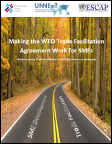 Making the WTO Trade Facilitation Agreement Work for SMEsSmall and Medium Enterprises (SMEs) comprise 95% of enterprises worldwide and provides at least two thirds of private sector employment. However, when it comes to international trade, SMEs experience limited capacity in dealing with the complex administrative and regulatory procedures associated with moving and selling goods across borders. This book fills a gap by providing a reference for articles of the World Trade Organization (WTO) Trade Facilitation Agreement (TFA) that are particularly beneficial to SMEs, and identifies examples of SME-specific programs, measures and interventions that can support the implementation of such provisions. It proposes mainstreaming relevant elements of the WTO TFA in existing SME policies and initiatives, to ensure that it contributes toward internationalization of SMEs.
Author: UNESCAP, UNNExT, and ITC Year: 2016 Download Tags: Small and Medium Enterprise, Trade Facilitation, Trade, UNESCAP, Small and Medium Enterprises, India, Nepal Information and Communication Technologies for Trade and Transport FacilitationInformation and Communication Technologies (ICT) provides efficiencies that can deliver many advantages for trade and transport facilitation (TTF) including Single Windows, automated business processes, digitalization of procedures, simpler interaction and transmission of data, and faster decision-making abilities. This paper looks at the business needs of TTF and explains the requirements of an architectural model to support TTF, with policy makers in mind. It highlights the need to integrate and modernize ICT systems and architecture so that ICT can respond to the needs of trade and transport facilitation. Author: UNESCAP and UNNExT Year: 2016 Download Tags: ICT, Trade Facilitation, Transport Facilitation, Single Window, UNESCAP 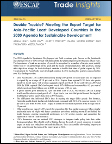 Double Trouble? Meeting the Export Target for Asia-Pacific Least Developed Countries in the 2030 Agenda for Sustainable Development (Trade Insights: Issue No. 15)This paper evaluates the prospects of least developed countries (LDCs) in Asia-Pacific in meeting the target set for LDCs to double their share of global exports by 2020, in Goal 17 of the Sustainable Development Goals (SDG). The paper notes that most Asia-Pacific LDCs have reported strong GDP growth turnout in recent years and are expected to grow by an average of 5.8% in 2016; difficulties faced by individual LDCs vary – Nepal, as an example, would need expansion at the average rate of 19% per year; LDCs can use national SDG strategies and go for longer-term goals—beyond the goals of export expansion—such as aiming to reach targets on trade cost reductions and trade facilitation. Author: Adam Heal, Miso Kim, Juliette Perche, Rajan Sudesh Ratna, and Pakkaporn Visetsilpanon Year: 2016 Download Tags: Least Developed Countries, Exports, Trade Facilitation, Trade, UNESCAP 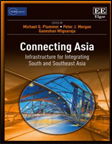 Connecting Asia: Infrastructure for Integrating South and Southeast AsiaThis book contains background papers prepared for the Asian Development Bank and the Asian Development Bank Institute joint study, 'Connecting South Asia and Southeast Asia.' It emphasizes the potential contribution to growth that greater connectivity—through better transport and energy infrastructure and improved soft infrastructure, including trade facilitation—between South Asia and Southeast Asia can foster. With benefits including greater participation in global supply chains for South Asia; lower trade costs; and increase in inter- and intraregional trade, the book underscores that, at a juncture where closer regional integration can secure sustainable and inclusive growth for economies in the two regions, specific policies should be examined and considered to enable both regions to maximize gains from greater integration. Author: Michael G. Plummer, Peter J. Morgan, Ganeshan Wignaraja, eds. Year: 2016 Download Tags: South Asia, Southeast Asia, Trade Facilitation, Transport, Energy, ADB, Economic Corridor, Bangladesh, India, Sri Lanka, ADB RCI 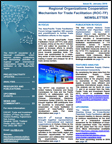 Regional Organizations Cooperation Mechanism for Trade Facilitation, Issue IX, January 2016This biannual publication features updates, publications and forthcoming activities of regional and international organizations working on trade facilitation in the Asia-Pacific region, including the Asian Development Bank (ADB), the World Customs Organization (WCO), and the United Nations Economic and Social Commission for Asia and the Pacific. It includes highlights of the Asia Pacific Trade Facilitation Forum 2015 and the Train-the-Trainer Workshops on Customs Valuation through Post Clearance Audit being jointly implemented by the WCO and ADB in the 6 SASEC member countries. This issue also features an analysis on achieving seamless supply chains through implementing comprehensive and pragmatic national trade facilitation reform programs. Author: UNESCAP Year: 2016 Download Tags: Trade Facilitation, Asia-Pacific, WCO, ADB, UNESCAP, Customs Valuation, Nepal, Bangladesh, Bhutan, India, Maldives, Sri Lanka Trade in Services: The Most Dynamic Segment of International TradeThe World Trade Organization (WTO) marks its 20th anniversary with a series of brochures to assist understanding of specific WTO agreements. This publication focuses on the WTO General Agreement on Trade in Services (GATS), which provides the legal ground rules for international trade in services, allowing WTO members the flexibility to open their markets to foreign competition to the extent of their choosing. GATS entered into force in 1995 and remains the only set of multilateral rules covering international trade in services. This brochures provides an overview of the different modes by which services are traded, commitments taken by WTO members, and developments enhancing GATS commitments and information on trade in services. Author: World Trade Organization Year: 2015 Download Tags: Services, Trade Facilitation, Economic Growth, WTO Technical Barriers to Trade: Reducing Trade Friction from Standards and RegulationsThe World Trade Organization (WTO) marks its 20th anniversary with a series of brochures to assist understanding of specific WTO agreements. This publication provides an overview of the WTO Agreement on Technical Barriers to Trade (TBT), which aims to ensure that technical regulations, standards, and conformity assessment procedures are non-discriminatory and do not create unnecessary obstacles to trade. It reviews how the TBT Committee, a unique multilateral forum for the discussion of standards and regulations affecting trade comprising WTO members, have created a predictable trading environment by enacting transparency provisions, and facilitated trade by encouraging WTO members to base their measures on international standards. Author: World Trade Organization Year: 2015 Download Tags: Technical Barriers to Trade, Trade, Trade Facilitation, WTO 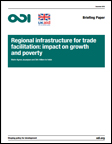 Regional Infrastructure for Trade Facilitation: Impact on Growth and Poverty Reduction - Policy SummaryThis research aims to provide evidence on the effects of regional infrastructure and associated trade cost reduction on growth and poverty reduction of economic actors, including households and firms, around the border. Data shows that investment in regional integration for trade facilitation (RITF) promotes economic activity, supports activity of informal traders, and facilitates integration into global value chains and international production networks. The report highlights that new hard infrastructure benefits economic actors more when complementary regulations that allow for efficient trade logistic services are also put in place. It recommends that policymakers account for the impact of RITF on reducing constraints to connectivity in their evaluations and policy decisions. Author: Marie-Agnes Jouanjean and Dirk Willem te Velde Year: 2015 Download Tags: Trade Facilitation, Global Value Chains, Poverty Reduction Disentangling Transit Costs and Time in South AsiaLandlocked least developed countries are often hugely disadvantaged from a lack of effective transit options, which raise transportation costs and decrease their effective participation in international trade. This study examines trade barriers that impede the trade flow of Bhutan and Nepal through India's gateway ports of Haldia and Kolkata, under the overarching research theme of the impact of regional infrastructure for trade facilitation on growth and poverty reduction. It analyzes the impact of transit regulations and agreements on the cost of services required to transit goods between the ports and Bhutan or Nepal, to identify how the two landlocked countries are affected by the cost of transit services, which trade costs vary most significantly, and how firms are affected by the cost of transit services. Author: Prabir De, editor Year: 2015 Download Tags: Trade Facilitation, Transport Facilitation, Bhutan, Nepal 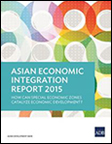 Asian Economic Integration Report 2015: How Can Special Economic Zones Catalyze Economic Development?The 2015 Asian Economic Integration Report reviews regional economic cooperation and integration in Asia, providing updates on recent developments affecting trade policy, including the conclusion of Trans-Pacific Partnership, relatively large number of proposed FTAs--with India among the major proponents, and progress of trade facilitation in Asia through the World Trade Organization's Trade Facilitation Agreement. Trade facilitation in developing Asia has significantly advanced over the last several decades, with a total of 48,000 kilometers of regional transport corridors along major supply chains improved. From 1992 to 2014, developing Asia together with ADB and its partners have mobilized $38.4 billion for 186 regional transport and trade facilitation investment projects under three subregional programs—including the South Asia Subregional Economic Cooperation (SASEC) program. This also issue includes a special chapter highlighting how special economic zones can catalyze economic development, with the right business environment and policies in place. Author: Asian Development Bank Year: 2015 Download Tags: Special Economic Zones, Trade Facilitation, Transport 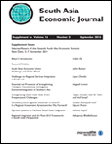 South Asia Economic Journal: Supplement Issue: Papers of the Seventh South Asia Economic SummitThis special issue of the South Asia Economic Journal contains papers presented at the 7th South Asia Economic Summit. With South Asia moving toward a South Asia Economic Union (SAEU), several major challenges remain, including reduction in the sensitive list, removal of Non-Tariff Barriers, effective and faster implementation of the South Asian Agreement on Trade in Services, effective regional investment cooperation, promotion of trade facilitation measures, promotion of regional value chains, cross-border energy cooperation. The articles in this volume tackle these critical issues to develop a way forward and generate ideas on policy priorities. A paper by Mr. Nagesh Kumar, UNESCAP-SSWA, on 'Potential and Prospects of Strengthening Transport Connectivity for Regional Economic Integration in Southern Asia' also discusses how two planned extended transport corridors can only facilitate trade and draw South Asia closer to its potential to become a hub of Asia–Europe trade. Author: Prabir De, editor Year: 2015 Download Tags: SAARC, South Asian Economic Union, Trade Facilitation, Transport 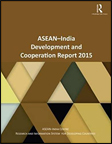 ASEAN-India Development and Cooperation Report 2015Re-engagement between India and ASEAN through increased cooperation across a range of issues, including trade and connectivity, is set to boost prosperity, competitiveness, growth and integration. With negotiations underway to establish a comprehensive free trade area through the Regional Comprehensive Economic Partnership, economic integration between India and Southeast and East Asia is set to scale new heights – further highlighting need for economic corridors with adequate cross-border infrastructure facilities that could facilitate increased production and services networks between ASEAN and Indian economies. This Report brings together experts and researchers who weigh in on ASEAN-India relations, analyzing the impact and implications of integration; assessing policy priorities, effectiveness, implementation imperatives and challenges; and discussing themes central to the economic sustainability of the region. Author: ASEAN–India Centre, Research and Information System for Developing Countries Year: 2015 Download Tags: ASEAN, India, Trade, Trade Facilitation 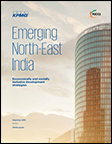 Emerging North-East India: Economically and Socially Inclusive Development StrategiesThis report highlights opportunities that can be explored in India's North East region, including tourism, energy, and infrastructure, to enable the North East to develop economically, while contributing to India's development as a whole. It takes stock of recent initiatives, including the 'Look East' Policy and the Bangladesh-Bhutan-India-Nepal (BBIN) subregional grouping, and identifies areas for improvement to propel inclusive growth. Harnessing the region's full potential would require upgrading the region's infrastructure. Significant investments are needed, since lack of connectivity and inadequate infrastructure present developmental bottlenecks, contributing to the slow pace of growth in the North East. The report presents policy recommendations and suggested actions, and a forecast for India for 2021-2022. Author: KPMG India and FICCI Year: 2015 Download Tags: India, BBIN, Connectivity, Transport, Trade Facilitation CPD Working Paper 110 – Trade and Transport Facilitation in Bangladesh: An Audit of the State of PlayThis publication provides a detailed picture of the status of specific measures for trade and transport facilitation in Bangladesh. It identifies measures already adopted, including strengthening of trade-related institutions, improvements in Customs processes and procedures, and reduction of non-trade barriers, highlighting areas for improvement and identifying existing gaps, to allow for proposals to meet these gaps. The audit undertaken aims to support policy-makers in Bangladesh in mobilizing the financial resources required to build a modern and efficient trade and transport facilitation system. Author: Mustafizur Rahman, Khaleda Akhter and Naimul Gani Saif Year: 2015 Download Tags: Trade Facilitation, Bangladesh, Customs World Trade Report 2015The World Trade Report 2015 is the first major study to comprehensively examine the benefits and challenges of implementing the World Trade Organization's Trade Facilitation Agreement (TFA) since its adoption in 2014. It discusses the importance of implementation of the TFA, its economic impact, and the steps being taken by the WTO to enable countries to maximize its benefits. This report presents further evidence that speedy and extensive implementation of the TFA will lead to bigger gains, particularly for developing countries and least developed countries. Author: World Trade Organization Year: 2015 Download Tags: Trade, LDC, Trade Facilitation 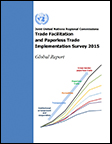 Joint UNRCs Trade Facilitation and Paperless Trade Implementation Survey 2015: Global ReportThis Report features results of the first UNRCs Joint Survey on Trade Facilitation and Paperless Trade Implementation, providing an overview of the current state of trade facilitation implementation in 119 economies across 8 regions worldwide. Though this Joint Survey finds that global average implementation rate of trade facilitation measures considered in the report stands at 52.9%, South Asia ranks below 40%. In the authorized operators and establishment and publication of average release times - categorized under the formalities measures - South Asia ranks below 10%. However, the region fares better in the institutional and cooperation measures, in particular with the recommendation to establish National Trade Facilitation Committees, with this measure most implemented in South Asia. The Report ranks India as the region's top performer in implementation of trade facilitation measures. Author: United Nations Regional Commission Year: 2015 Download Tags: Trade Facilitation, South Asia, Customs Bangladesh-Bhutan-India-Nepal Motor Vehicles Agreement: Unlocking the Potential for Vibrant Regional Road Freight ConnectivityThe Bangladesh-Bhutan-India-Nepal Motor Vehicles Agreement (BBIN MVA) is expected to reduce trade transaction costs and be an effective tool to realize trade and investment potential in the subregion by generating new economic opportunities, particularly in the border areas. While it has put in place a good framework for facilitating transit and transport within BBIN, gaps remain in terms of interpretation and application of various procedures, and need for further policy harmonization among the contracting parties. This discussion paper analyzes operation issues and proposes solutions for cross-border movement of vehicles and Customs procedures. Author: Pritam Banerjee Year: 2015 Download Tags: BBIN, Trade Facilitation, Transport 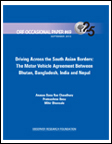 Driving Across the South Asian Borders: the Motor Vehicle Agreement between Bhutan, Bangladesh, India, and NepalThis paper discusses the benefits of strengthening physical connectivity in the Bangladesh-Bhutan-India-Nepal (BBIN) subregion through a Motor Vehicle Agreement (MVA). Through a framework that envisions transforming transport corridors into economic corridors and with its pipeline of 30 priority transport connectivity projects estimated at $8 billion, the MVA aims to increase intraregional trade in South Asia by almost 60%. This publication provides a concise background on the BBIN MVA, examining the circumstances leading to its signing, the role of the Asian Development Bank (ADB) and the ADB-supported SASEC Program initiative to enhance interconnectivity, challenges that require careful consideration, and its wider implications for the South Asian region. Author: Anasua Basu Ray Chaudhury, Pratnashree Basu, and Mihir Bhonsale Year: 2015 Download Tags: Transport, Trade Facilitation, BBIN World Trade Organization Annual Report 2015The World Trade Organization (WTO) Annual Report 2015 provides an overview of WTO activities in 2014 and early 2015. It presents a timeline of two decades of the WTO -- from its origins succeeding the General Agreement on Tariffs and Trade to its current role in the multilateral trading system. It presents a chapter on how WTO helps developing countries build trade capacity and allows them to implement trade agreements. WTO training courses are organized for officials from developing countries each year. Author: World Trade Organization Year: 2015 Download Tags: Trade, Trade Policy, WTO, Tariffs, Energy, Bangladesh, India, Nepal, Sri Lanka, Trade Facilitation, Transport, Asia, Agriculture 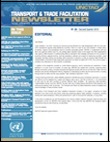 UNCTAD Transport and Trade Facilitation Newsletter No. 66 – Second Quarter 2015The Transport and Trade Facilitation Newsletter highlights trade facilitation support across countries and shares innovations from Cote d’Ivoire and Greece, including the new UNCTAD Technical Note on World Trade Organization (WTO) Trade Facilitation Agreement (TFA) ratification. It also features the meeting of the Global Facilitation Partnership for Transportation and Trade -- an event that brings together the private sector, WTO Member States and international organizations -- in a discussion to support TFA implementation. The Newsletter further shows United Nations Regional Commissions Global Survey on Trade Facilitation and Paperless Trade -- a response to the lack of comprehensive cross-country data and a guide to better understand and monitor trade facilitation implementation and paperless trade measures. Author: United Nations Conference on Trade and Development Year: 2015 Download Tags: Transport, Trade Facilitation, WTO, UNCTAD UNRCs Trade Facilitation and Paperless Trade Implementation Survey 2015: Asia and the Pacific Report This report presents data on trade facilitation and paperless trade implementation from 44 economies across the Asia-Pacific region, covering 5 different subregions. It lays out key findings on implementation levels of general trade facilitation measures and ICT-based trade facilitation measures across the region, and provides empirical evidence for advancing trade facilitation. Findings suggest that there is still significant room for progress. In South Asia, regional average trade implementation comes a little above 40%. The report also noted that cross-border paperless trade facilitation is the least implemented of all groups of measures. Author: United Nations Economic and Social Commission for Asia and the Pacific Year: 2015 Download Tags: Trade Facilitation, Asia-Pacific, ICT WTO Dispute Settlement and Industrial PolicyThis paper explores the World Trade Organization's (WTO) dispute settlement mechanism in relation to the space it provides for Member countries’ industrial policies. It provides general conceptual reflections covering the role of WTO panels and the Appellate Body and the nature and categorization of WTO legal provisions applicable to trade in goods; and discusses how dispute settlement in WTO can affect or expand the policy space available to WTO Members in adopting industrial policy measures. This paper presents several examples that demonstrate the potential impact of WTO adjudicatory bodies on the policy space of WTO Members to implement and pursue industrial policy measures. Author: Jan Bohanes Year: 2015 Download Tags: WTO, Trade Facilitation, Policy Aid for Trade in Asia and the Pacific 2015This Asian Development Bank report explores the potential of the digital economy to improve the inclusiveness of Aid for Trade (AfT). It uses the review of AfT as a springboard to explore new ways of thinking and how to address issues such as high trade costs in some regions. In particular, it considers how to build on information and communications technology and infrastructure connectivity from established AfT spending. The report also highlights the experience of exporters to illustrate the unique challenges and opportunities for trade-driven growth in a region where high trade costs are structural. Author: Alisa Di Caprio and Kati Suominen Year: 2015 Download Tags: ICT, Infrastructure, Trade, ADB, Asia-Pacific, Exports, Economic Growth, Trade Facilitation 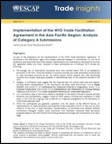 Implementation of the WTO Trade Facilitation Agreement in the Asia-Pacific Region: Analysis of Category A SubmissionsWorld Trade Organization (WTO) Trade Facilitation Agreement (TFA) provisions notified under Category A are those that WTO Member States have already implemented or have committed to implement by the time the Agreement enters into force or, in the case of the least-developed countries (LDCs), within a year of its entry into force. Provisions not included under this category are those which will require capacity building and technical assistance, or presumably take longer to implement. This trade insight paper analyzes Category A notifications of 15 economies in the Asia-Pacific region, contrasting the results with findings from an earlier ESCAP Survey on Implementation of Trade Facilitation and Paperless Trade (SITFAP) 2013/14 in order to examine some of the most challenging WTO TFA provisions, and gain insights on regional priorities for cooperation and capacity building. Author: Yann Duval and Pamela Bayona Year: 2015 Download Tags: Trade Facilitation, WTO, Least Developed Countries, UNESCAP Mega-regionals and the Regulation of Trade: Implications for Industrial PolicyThis report reviews key industrial policy issue areas being negotiated in mega-regional free-trade agreements—in particular, the Trans-Pacific Partnership—and evaluates how possible outcomes will impact the international trading system. Reviewing areas where the mega-regionals may impose systemic constraints, including border measures, technical barriers to trade, sanitary and phytosanitary measures, and e-commerce measures, the report discusses a possible future framework for industrial policy that integrates the additional policy constraints and changes introduced by these agreements. Author: Dan Ciuriak and Harsha V. Singh Year: 2015 Download Tags: Trade, Trade Facilitation, Free Trade Agreements Connecting South Asia and South East Asia This book analyzes how closer regional connectivity and economic integration between South Asia and Southeast Asia can benefit both subregions. It aims to build a broad case for increased connectivity between the two regions and identify specific projects that have high potential to fulfill this objective. This joint study focuses on both “hard” infrastructure and associated “soft” infrastructure, including tariffs and non-tariff barriers, trade and transport facilitation, energy trading, and infrastructure investment and financing. It further provides a canvas for considering strategic cross-border infrastructure investments and policy reforms. Author: Asian Development Bank Institute and Asian Development Bank Year: 2015 Download Tags: South Asia, Southeast Asia, Connectivity, Economic Corridor, Transport, Trade Facilitation, Bangladesh, India, Sri Lanka Developing Economic Corridors in South Asia This book describes key conditions for transforming transport corridors into economic corridors and establishes the rationale for developing economic corridors, and the related benefits from production value chains along those corridors. It further emphasizes the significant potential of economic corridors in South Asia, particularly those being developed under the South Asia Subregional Economic Cooperation Program. The chapters highlight the impact of trade barriers on bilateral trade and present case studies on trade facilitation in South Asia. Countries in the subregion would benefit by working closely to exploit the full economic potential of economic corridors. Author: Asian Development Bank Year: 2014 Download Tags: Economic Corridor, South Asia, Trade Facilitation, Bangladesh, India, Sri Lanka, ADB, SASEC, Bilateral Trade, Transport National Trade Facilitation Bodies in the World This UNCTAD publication provides the first, in-depth quantitative analysis of 50 existing national trade facilitation bodies and a first-hand set of recommendations from experiences of participating stakeholders. It offers policy-oriented conclusions to assist countries about to set up or strengthen their national trade facilitation working groups. The study reveals that the biggest challenge for trade facilitation working groups is sustainability. Its determining elements include the administrative culture of each country, level of development, or type of body and geographical region. Author: United Nations Conference on Trade and Development Year: 2014 Download Tags: Trade Facilitation, Trade Policy, Sustainability, UNCTAD, Bangladesh, Bhutan, Nepal, Sri Lanka UNCTAD Transport Newsletter: Fourth Quarter 2014This United Nations Conference on Trade and Development (UNCTAD) newsletter focuses on the development dimension and benefits of the World Trade Organization Trade Facilitation Agreement. It includes sections on the national trade facilitation committees, project proposal for the implementation of trade facilitation measures contained in the agreement, and improvement in implementation of sanitary and phytosanitary measures to facilitate trade. It also includes UNCTAD’s contribution to trade facilitation in Landlocked Developing Countries and Small Island Developing States. Author: United Nations Conference on Trade and Development Year: 2014 Download Tags: Trade Facilitation, WTO, UNCTAD, Transport, Development, Sanitary and Phytosanitary Measures, Energy, India NTMs in South Asia: Assessment and AnalysisThe study “NTMs in South Asia: Assessment and Analysis” analyzes how Non-tariff Measures (NTMs) give rise to non-tariff barriers, which are becoming increasingly crucial for advancing trade cooperation among member countries of the South Asian Association for Regional Cooperation, yet remain less-addressed. The study examines export potential and actual export of South Asian countries, and attempts to highlight gains from reduction in transaction costs in bilateral trade. It also notes that initiatives for trade facilitation reforms in South Asia at the regional level remain low in incentives and have yet to produce significant results. The study closes with several recommendations for reducing and eliminating NTMs. Author: Selim Raihan, Mostafa Abid Khan, and Shaquib Quoreshi Year: 2014 Download Tags: Trade Facilitation, Trade, SAARC, Bangladesh, Bhutan, India, Maldives, Nepal, South Asia, Sri Lanka  The Connectivity AgendaThis article appeared in the special issue of My Republica published on the occasion of the 18th SAARC Summit. Mr. Ronald Antonio Q. Butiong, Unit head of the South Asia Subregional Economic Cooperation (SASEC) Regional Cooperation and Operations Coordination Division of the Asian Development Bank (ADB), traces the blueprints of SASEC projects to the South Asian Association for Regional Cooperation (SAARC) Regional Multimodal Transport Study (2006) and SAARC Regional Energy Trade Study (2010); two studies supported by ADB and endorsed by SAARC member states. Highlighting the SASEC focus to promote economic cooperation in the subregion by developing cross-border connectivity and facilitating intra-regional trade in South Asia through its priority sectors—energy, transport, and trade facilitation—Mr. Butiong explains how ADB is providing assistance to sections of Bangladesh, Bhutan, India, and Nepal along SAARC corridors through SASEC. Featuring a brief discussion of key SASEC projects and technical assistance (since 2001, 33 projects implemented, worth over US$6 billion) alongside institution and capacity-building support, the article shows how the SASEC connectivity agenda is part of achieving SAARC development objectives. Author: Ronald Antonio Q. Butiong Year: 2014 Download Tags: SAARC, Energy, Transport, Trade Facilitation Bridging Transport, ICT, and Energy Infrastructure Gaps for Seamless Regional ConnectivityThis publication is a contribution by the United Nations Economic and Social Commission for Asia and the Pacific to deliberations at the Second United Nations Conference on Landlocked Developing Countries (LLDCs) in Vienna, Austria, 3-5 November 2014. It shows regional connectivity as an unfinished agenda and bridging infrastructure gaps as a complex challenge for LLDCs. While physical infrastructure is a priority, this report argues that deeper regional integration – through regionally cohesive and terrestrial networks – is key to effectively linking Asian LLDCs to the region’s infrastructure networks. Author: United Nations Economic and Social Commission for Asia and the Pacific Year: 2014 Download Tags: Transport, ICT, Energy, UNESCAP, SASEC, Connectivity, Infrastructure, Bangladesh, India, Nepal, Sri Lanka, Trade, Trade Facilitation, Policy, Trade Policy Asian Economic Integration Monitor: November 2014This AEIM review of recent economic performance highlights the need for Asia to rebalance its sources of growth toward domestic and regional demand. It also shows a resilient Asia with rising GDP growth in South Asia. This issue includes a Special Chapter: Regional Financial Integration and Crisis in Asia and Europe – A Comparative Analysis. It presents Asia’s future path of integration as different from that in Europe. Asia will continue to strengthen efforts to harmonize rules and regulations in the financial sector and further unilateral trade and investment, while Europe is more likely to strengthen regional institutions to ensure recovery and better the monetary union. Author: Asian Development Bank Year: 2014 Download Tags: Asia-Pacific, Economic Integration, Europe, ASEAN, Bangladesh, Bhutan, India, Maldives, Nepal, Regional Integration, Sri Lanka, Trade Facilitation, Transport SASEC Website BrochureThis promotional brochure for the SASEC website features the web portal as a one-stop shop for information on SASEC activities, events, projects, and knowledge materials. The SASEC website seeks to build a dynamic discussion platform and repository of data on regional cooperation. Author: Asian Development Bank Year: 2014 Download Tags: SASEC, Knowledge Product, ICT, ADB, Bangladesh, Bhutan, India, Maldives, Nepal, South Asia, Transport, Trade Facilitation, Energy SASEC BrochureThis promotional brochure is a concise introduction to the South Asia Subregional Economic Cooperation (SASEC) Program, highlighting the main areas of regional cooperation and activity. It includes facts and figures about SASEC projects in transport, trade facilitation, energy, and ICT. Author: Asian Development Bank Year: 2014 Download Tags: SASEC, Trade Facilitation, Regional Cooperation, ICT, ADB, Bangladesh, Bhutan, India, Nepal, Maldives, Sri Lanka, Energy, Transport, Connectivity, Myanmar 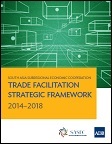 SASEC Trade Facilitation Strategic Framework 2014-2018The South Asia Subregional Economic Cooperation (SASEC) Trade Facilitation Strategic Framework 2014-2018 builds on the momentum of member countries over recent years in forging ahead with many significant improvements to facilitate, and ultimately increase, trade in the subregion and with the rest of the world. It supports the mission of the SASEC Transport and Trade Facilitation Strategy “to promote the prosperity of the subregion by facilitating the efficient movement of trade across the borders”, and focuses on five priority areas: customs modernization and harmonization; standards and conformity assessment strengthening; cross-border facilities improvement; through-transport facilitation; and institution and capacity building. Author: Asian Development Bank Year: 2014 Download Tags: SASEC, Trade Facilitation, Regional Cooperation, Transport, Trade, Customs, Standards, Harmonisation, Regional Integration, ADB, Bangladesh, Bhutan, India, Maldives, Nepal, Sri Lanka, South Asia, ADB RCI 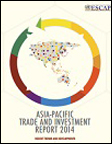 Asia-Pacific Trade and Investment Report 2014: Recent Trends and DevelopmentsThis Asia-Pacific Trade and Investment Report 2014 provides an analysis of recent regional trends and developments in: (a) intraregional trade in goods and services; (b) foreign direct investment (FDI);
(c) trade facilitation measures; (d) trade policy measures; and (e) preferential trade agreements. According to this report, South and South West Asia’s FDI inflow improved, registering a 6% increase, with India holding the largest FDI share. However, performance in key trade and investment indicators was weak in 2013, with merchandise exports decreasing by 0.2%, around 71% of exports going to destinations outside the Asia-Pacific region, and around 64% of merchandise being imported from extra-regional sources. This publication also provides a preliminary regional assessment of the implementation of trade facilitation measures included in the TFA. This section concludes by identifying areas that countries need to focus on in order to further advance trade facilitation in the region. Author: UNESCAP Year: 2014 Download Tags: FDI, Trade, Trade Facilitation World Trade Report 2014 – Trade and Development: Recent Trends and the Role of the WTOThis annual publication highlights the relationship between trade and development, including changes since the start of the millennium. It identifies four key trends that altered the way trade affects development outcomes – accelerated economic growth in developing countries, expansion of global value chains, increase in agricultural and natural resource prices, and global nature of macroeconomic shocks. This report also explores how these trends have reshaped the role of trade in facilitating development and how recent development gains allow developing countries to adapt and mitigate risks. Author: World Trade Organization Year: 2014 Download Tags: WTO, Global Value Chains, Trade, Economic Growth, Agriculture, Trade Facilitation, Development, Bangladesh, Bhutan, India, Maldives, Nepal, South Asia, Sri Lanka 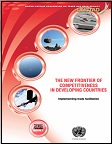 The New Frontier of Competitiveness in Developing Countries: Implementing Trade FacilitationThis report presents an overview of implementation challenges for realizing trade facilitation reforms. It consolidates results of 26 national trade facilitation implementation plans in 26 countries, comprising least developed countries, middle-income developing countries, landlocked countries, and small island economies in Africa, Asia, the Caribbean and Latin America. In the 26 countries surveyed, the level of implementation of trade facilitation measures in the World Trade Organization (WTO) is considerably lower in least developed countries (LDCs) than in developing countries. Since trade facilitation still remains a major challenge for developing countries and LDCs, an international legal regime with special and differential treatment will help developing WTO members achieve further progress. Author: United Nations Conference on Trade and Development Year: 2014 Download Tags: Trade Facilitation, Asia-Pacific, WTO, Bangladesh, Bhutan, Nepal Impact of Trade Facilitation on Foreign Direct InvestmentThis United Nations Economic and Social Commission for Asia and the Pacific Trade and Investment Working Paper attempts to quantify the potential impact of trade facilitation on foreign direct investment (FDI) flows. The study uses bilateral FDI data from 2006 onward from both developing and developed countries, including South-South FDI flows, wherein contiguity (common border between source and host country) and geographic distance are found to be much more important factors. In applying an augmented FDI model framework to determine the effect of comprehensive international trade costs, the results show that both non-tariff and tariff costs are important determinants of FDI inflows. Author: Yann Duval and Chorthip Utoktham Year: 2014 Download Tags: FDI, Trade Facilitation, Bilateral Trade, UNESCAP, Investment, Tariff, Bangladesh, Maldives 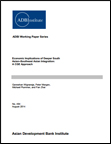 Economic Implications of Deeper South Asian–Southeast Asian Integration: A CGE ApproachHigh tariff and non-tariff barriers, and costly transport links and inefficient trade facilitation measures continue to hamper the growth of trade between South Asia and Southeast Asia. This paper explores whether potential gains from improved connectivity—via Myanmar as inter-regional bridge—justify a high level of investment. Using an advanced computable general equilibrium (CGE) model, reduction of inter-regional tariffs, decreasing of non-tariff barriers by 50%, and cutting down of trade costs between South Asia and Southeast Asia by 15% yields a prediction of 8.9% rise in welfare in South Asia and Southeast Asia, and an increase of 6.4% in gross domestic product by 2030. Author: Ganeshan Wignaraja, Peter Morgan, Michael Plummer, and Fan Zhai Year: 2014 Download Tags: Transport, Trade Facilitation, South Asia, Southeast Asia, Regional Integration, Tariff, Trade, Connectivity, Investment, Myanmar, GDP 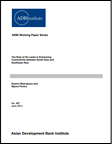 The Role of Sri Lanka in Enhancing Connectivity between South Asia and Southeast Asia As Sri Lanka rebuilds at the end of a 30-year conflict, its progress in improving physical infrastructure—including the Colombo port expansion and other programs for new expressways and road connectivity—has been significant. Yet, the country has seen a sharp decline in its overall exports-to-gross domestic product ratio. How Sri Lanka can benefit from greater connectivity with its neighbors in South Asia and Southeast Asia is discussed in this paper. Trade policies geared towards enhancing regional integration efforts could boost Sri Lanka's economy. Additionally, to lessen the challenges of financing and sustaining implementation of planned infrastructure development efforts, Sri Lanka could also implement a more stringent institutional and regulatory environment encouraging more private sector participation. Author: Dushni Weerakoon and Nipuni Perera Year: 2014 Download Tags: Trade Policy, Trade Facilitation, Sri Lanka, Connectivity, South Asia, Southeast Asia, ADB, Transport, Regional Integration 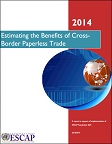 Estimating the Benefits of Cross-Border Paperless TradeCross-border paperless trade is trade that occurs on the basis of electronic communications and has been part of customs reform efforts in a variety of countries. Increased implementation of cross-border paperless trade is high on the trade facilitation agenda in Asia-Pacific. This report considers six measures to calculate estimates of possible economic benefits of cross-border paperless trade through counterfactual simulations using 2013 data and simple econometric models. Simulation results reveal that this new generation of trade facilitation can significantly reduce trade costs and boost intra- and extra-regional trade in the region. Partial implementation of these measures can lead to an export increase of $36 billion annually. Total direct cost savings across all trade is about $1 billion per annum for partial reform, and $7 billion for full implementation. Author: United Nations Economic and Social Commission for Asia and the Pacific Year: 2014 Download Tags: Trade Facilitation, Trade, Asia-Pacific, UNESCAP, Customs, Export, Bangladesh, Bhutan, India, Maldives, Nepal, Sri Lanka 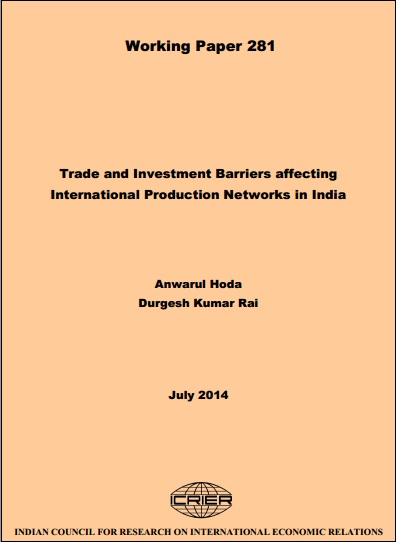 Trade and Investment Barriers Affecting International Production Networks in IndiaRecognizing India as an outlier in development of international production networks with the lowest participation among Asian countries, this study investigates the reason for India’s lackluster participation in production-sharing networks. Using desk work, field surveys, and interviews, an analysis is adopted with three comparator countries in the region that have been successful in production-sharing arrangements as well as industrial growth – China, Malaysia, and Thailand. It further describes foreign direct investment inflows into India, analyzes behind-the-border investment environment, and provides recommendations to improve investment climate and hasten the pace of manufacturing development in India. Author: Anwarul Hoda and Durgesh Kumar Rai Year: 2014 Download Tags: India, Trade, Production Networks, Investment, Thailand, Manufacturing, Customs, Economic Corridor, Energy, Trade Facilitation, Transport The Long and Winding Road: How WTO Members Finally Reached a Trade Facilitation Agreement The conclusion of the Agreement on Trade Facilitation at the Bali negotiations in December 2013 marked the end of a journey that lasted almost a decade. As the first multilateral trade agreement successfully negotiated by World Trade Organization (WTO) ministers, it broke new ground in the decentralized, bottom-up way the negotiations were structured; in the manner the capacities and resources of developing countries were addressed; and in how the Agreement has shifted the system’s focus beyond policy barriers toward process frictions. The negotiated outcome is likely to have an impact not just on Trade Facilitation, but on the WTO and the multilateral trading system as a whole. Author: Nora Neufeld Year: 2014 Download Tags: Trade Facilitation, Trade Policy, Regional Cooperation, WTO, India 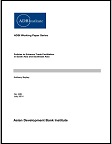 Policies to Enhance Trade Facilitation in South Asia and Southeast AsiaThis Asian Development Bank Institute publication identifies the state of play of trade facilitation and provides an overview of intra- and inter-regional trade in South and Southeast Asia. It highlights key challenges and bottlenecks to effective trade facilitation, ranging from the lack of expert human resources such as information technology specialists in small landlocked countries (Bhutan and Nepal), to the high border transaction costs and severe congestion faced at border crossing points, and the lack of effective dialogue on bilateral enhancement of trade facilitation. Regional initiatives such as the South Asia Subregional Economic Cooperation Program aim to address these challenges through customs modernization and harmonization, automation, and the use of international best practices in border procedures. Author: Anthony Bayley Year: 2014 Download Tags: South Asia, Trade Facilitation, Trade Policy, Southeast Asia, ADB, ICT, Bhutan, Nepal, SASEC, Customs 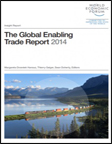 The Global Enabling Trade Report 2014The Global Enabling Trade Report offers a tool to monitor progress on implementing measures for the Trade Facilitation Agreement. Benchmarking the performance of 138 economies in four critical areas, including border administration, the Report takes off from the success of the Bali package by emphasizing measures that facilitate trade at a more practical level, with benefits that significantly outweigh the cost of necessary reforms and produces positive spillover effects on other indicators—market access, infrastructure, and operating environments. Also mentioned are insights on further boosting trade facilitation within the region, such as regional cooperation and sharing of good practices. The Report is intended as a motivator for change at a time of renewed momentum for trade facilitation where windows of opportunities for policymakers to push through trade-enabling measures are open. Author: Margareta Drzeniek Hanouz, Thierry Geiger, Sean Doherty (eds.) Year: 2014 Download Tags: Trade Facilitation, Bangladesh, India, Nepal, South Asia, Sri Lanka Trade Facilitation and Paperless Trade ImplementationThis paper reports survey findings on progress in implementing various trade facilitation and paperless trade measures made by 29 countries in Asia and the Pacific, including six SASEC member countries. Factors considered include pre-arrival clearance, post-clearance audit, National Single Window, and authorized operator programmes. The survey reveals that while countries have prioritized automation and paperless trade at the regional level, there is an urgent need for regional arrangements that will facilitate cross-border exchange of trade-related electronic documents and information to enable smoother trade facilitation. Author: Tengfei Wang and Yann Duval Year: 2014 Download Tags: Trade Facilitation, Regional Cooperation, Trade, Asia-Pacific, SASEC, Single Window, UNESCAP, Customs, Bangladesh, Bhutan, India, Maldives, Nepal, Sri Lanka WCO News: WTO Trade Facilitation AgreementWCO News is a biannual newsletter of the World Customs Organization (WCO). This issue, released in June 2014, focuses on the World Trade Organization's (WTO) Agreement on Trade Facilitation. WCO's commitment to its implementation is highlighted and linkages between articles of the Agreement and WCO instruments and tools are explored. Also included is a feature on the benefits Authorized Economic Operator programmes bring supply chain companies. Author: World Customs Organization Year: 2014 Download Tags: Trade Facilitation, WCO, WTO, Bangladesh, Customs, India, Sri Lanka 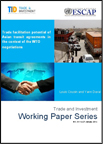 Trade Facilitation Potential of Asian Transit Agreements in the Context of the WTO NegotiationsFreedom of transit is an issue critical to landlocked developing countries whose lack of direct access to the sea has increased costs and lessened their competitiveness in international trade. To meet challenges arising from transit barriers, member states of the United Nations Economic and Social Commission for Asia and the Pacific recommend transit facilitation as part of an integrated approach to trade facilitation.
This working paper analyzes freedom of transit and transit facilitation in the context of trade and transport agreements in the Asia Pacific region, identifying good practices and weighing in on the extent to which existing agreements meet the provisions on transit facilitation stated in the draft text of the World Trade Organization Agreement on Trade Facilitation. Author: Louis Cousin and Yann Duval Year: 2014 Download Tags: Transport Facilitation, Trade Facilitation, WTO, Asia, UNESCAP, Bangladesh, Bhutan, India, Nepal Unpacking the Bali Package: a Snapshot of Bali Ministerial Decisions of WTO MembersThe Bali Package represents a key turning point for the World Trade Organization. Covering trade facilitation, agriculture, and trade issues for developing and least-developed countries, it is set to increase trade activity on a global scale and lower the cost of doing international trade. This paper acts as a precursor to its implementation by identifying challenges countries may face, giving a brief history of each pillar, exploring the next possible steps for each ministerial decision, and examining the likely effects of this decision/agreement on various other stakeholders, particularly on consumers. Author: Archana Jatkar and Chenai Mukumba Year: 2014 Download Tags: Trade, Trade Facilitation, Trade Policy, WTO, Agriculture, Least Developed Countries, India 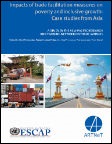 Impacts of Trade Facilitation Measures on Poverty and Inclusive Growth: Case Studies from Asia - A Study by the Asia-Pacific Research and Training Network on TradeThis book addresses the gap between trade facilitation and poverty reduction and contains a compilation of specific case studies that explores the linkages between trade facilitation measures and poverty. It also presents cross-country analysis that examines inequality in low- and middle-income countries. Other chapters discuss economic corridors and microfinance development as trade facilitation measures and examine access to trade facilitation by export-oriented micro, small, and medium-sized enterprises. It also explores barriers to international entrepreneurship for the vegetable business in Bangladesh. Finally, it offers a comprehensive evaluation of the effectiveness of Export Processing Zones (EPZs) on poverty reduction. Author: Ravi Ratnayake, Rajan Sudesh Ratna, Martina Francesca Ferracane and Yann Duval Year: 2013 Download Tags: Trade Facilitation, Bangladesh, Trade, Poverty Reduction, Economic Corridor, Small and medium enterprises, India, SAARC, Customs, Pakistan 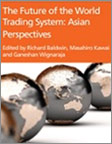 The Future of the World Trading System: Asian PerspectivesAccording to WTO Director-General Pascal Lamy, the problems facing Asian regionalism are a scaled-down version of the problems facing the world. Thus, solutions that address Asia’s noodle bowl would most likely work at the global level. This concise collection of short chapters is based on longer papers presented at the Geneva Conference on 11-12 March 2013, organized by the Asian Development Bank Institute and Centre for Trade and Economic Integration at the Graduate Institute of International and Development Studies, in collaboration with WTO. The chapters are written by leading Asian and international trade experts on key changes taking place in the world trading system and its policy implications for Asia. Author: Richard E. Baldwin, Masahiro Kawai, and Ganeshan Wignaraja, eds. Year: 2013 Download Tags: Regional Integration, Trade Policy, Trade, Global Value Chains, Global Production Network, Regional Trade, Trade Facilitation, India Connecting South Asia and Southeast Asia: Interim ReportThis joint ADB-ADBI study focuses on how improved physical connectivity (infrastructure) and associated institutional connectivity (software) can enhance more effective economic integration between the two subregions. The report reviews economic ties, identifies issues and constraints, and explores better connectivity and closer economic integration. It also examines major developments in South Asia-Southeast Asia trade and investment, economic cooperation, role of economic corridors, and regional cooperation initiatives. Author: ADB and ADBI Year: 2013 Download Tags: Infrastructure, Economic Integration, Regional Cooperation, Trade, Transport, Trade Facilitation, Economic Corridor, Energy The ASEAN Economic Community: A Work in ProgressThis publication explores the barriers and impediments to the realization of an ASEAN Economic Community (AEC), and to what extent its self-imposed deadline of 2015 for achievement of an AEC is more of a milestone of progress than a firm target. It examines whether the AEC is achievable, the obstacles faced in achieving it, and the measures required to help it become a reality. Author: Asian Development Bank Year: 2013 Download Tags: Regional Cooperation, Regional Integration, Trade Policy, ASEAN, Economic Integration, Regional Cooperation, ADB, Regional Integration, Services, Global Value Chains, Non-Tariff Measures, Asia-Pacific Trade Agreement, India, Trade Facilitation ADB Regional Cooperation Operations Business Plan (RCOBP) 2014-2016 for South AsiaADB's third Regional Cooperation Operations Business Plan (RCOBP) 2014-2016 for South Asia under its South Asia Regional Cooperation Strategy (RCS) 2011-2015 details a cumulative indicative lending program of $3.3 billion and maintains focus on improved regional connectivity, increased cross-border trade, and strengthened regional economic cooperation. Author: Asian Development Bank Year: 2013 Download Tags: Regional Cooperation, Regional Integration, Bangladesh, Bhutan, India, Maldives, Nepal, Sri Lanka, Trade Facilitation, Transport, Energy, SAARC Deepening Economic Cooperation between India and Sri LankaThis book analyzes the performance and impact of the India-Sri Lanka free trade agreement over the past decade and suggests the way forward. India became an important source of imports for Sri Lanka immediately after the implementation of the free trade agreement. Author: Asian Development Bank Year: 2013 Download Tags: Regional Cooperation, Trade Policy, India, Sri Lanka, Trade, Economic Cooperation, India-Sri Lanka Free Trade Agreement, Free Trade Agreements, Services, Trade Facilitation, Exports, Import Who Profits from Trade Facilitation Initiatives?This Asia-Pacific Research and Training Network on Trade (ARTNeT) Working Paper uses firm-level data on developing countries to investigate whether large firms benefit from trade facilitation. The findings show that firms of all sizes export more in response to improved trade facilitation. Trade facilitation can be beneficial to countries, including those engaged as suppliers in value chains. Author: Bernard Hoekman and Ben Shepherd Year: 2013 Download Tags: Trade Facilitation, Trade Policy Aid for Trade: An Investment Benefit Road Map for South AsiaAid for Trade (AfT) came to prominence just over a decade ago at the launch of the
World Trade Organization's Doha Round. With its focus on helping least developed
countries and economies escape the poverty trap, it aims to strengthen their
capabilities to meet market demand and to reduce supply-side constraints such as a lack of
trade infrastructure. Author: Asian Development Bank Year: 2013 Download Tags: Trade Policy, Poverty Reduction, Infrastructure, India, Bangladesh, Bhutan, Maldives, Sri Lanka, Nepal, Trade Facilitation, Transport, Global Value Chains, Exports 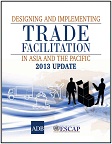 Designing and Implementing Trade Facilitation in Asia and the PacificThis reference book was published to support the implementation of trade facilitation measures and reforms in Asia and the Pacific. It includes operational guidance on assessing the status of trade facilitation, the measures and reforms needed, how to design trade facilitation initiatives, and how to implement them at national and regional levels. The book is intended to assist policy makers, practitioners, and economists by bridging the gap between theory and practice. The revised 2013 version includes updated statistical figures and data, information on actual trade facilitation policies and practices, and the most recent research on trade facilitation. Author: Asian Development Bank / United Nations Economic and Social Commission for Asia and the Pacific Year: 2013 Download Tags: Trade Facilitation, Regional Cooperation, Regional Integration, Trade Policy, Economic Corridor, Sanitary and Phytosanitary Measures, Technical Barriers to Trade, Revised Kyoto Convention, Customs, Customs Valuation, Bangladesh, Bhutan, India, Nepal, Maldives, Sri Lanka, Services Asia-Pacific Trade Facilitation Forum: Survey on Trade Facilitation and Paperless TradeConducted jointly by the Asian Development Bank and the United Nations Economic and Social Commission for Asia and the Pacific, this survey provides a status snapshot of trade facilitation in place across 26 countries of the region, including progress towards establishment of national trade facilitation committees, implementation of risk management measures, development of national single windows, and steps taken to move toward paperless trade. It further examines specific issues and challenges in these areas of South East Asian countries, and provides recommendations for improvement. Author: ADB and UNESCAP Year: 2012 Download Tags: Trade Facilitation, Paperless Trade, Bangladesh, Bhutan, India, Nepal, Maldives, Sri Lanka, Customs, Transport Facilitation, Myanmar, National Single Window Unlocking Bangladesh-India Trade: Emerging Potential and the Way ForwardThis working paper breaks down the importance of trade cooperation between Bangladesh and India by taking a closer look at the impacts of Bangladesh's increased market access to India, and their improved border connectivity. Employing data from national government resources and multilateral development organizations including the International Monetary Fund, World Bank, and World Trade Organization, the study provides an estimate of the trade potential of Bangladesh and India, and calculates the implications on costs of trade facilitation, among others. It also discusses ongoing challenges in bilateral relations and provides recommendations that will enable larger gains for the two contiguous countries. Author: Prabir De, Selim Raihan, and Sanjay Kathuria Year: 2012 Download Tags: Trade, Trade Facilitation, Regional Cooperation, Bangladesh, India, WB, WTO, Bilateral Trade Sector Roadmaps with Result FrameworksSector roadmaps with result frameworks for transport, energy, and trade facilitation. Author: Asian Development Bank Year: 2011 Download Tags: Trade Facilitation, Energy, Transport, Bangladesh, Bhutan, India, Maldives, Nepal, Sri Lanka South Asia- Intra Regional Cooperation: The Way ForwardThis study aims to showcase the benefits of regional integration and recommends strategies for overcoming the many hurdles. Author: Shahid Kardar Year: 2011 Download Tags: Policy, Economic Cooperation, Regional Integration, Development, SAARC, Non-Tariff Measures, Trade Facilitation, SAFTA, India, Bangladesh, Bhutan, Maldives, Nepal, Sri Lanka, BIMSTEC, Myanmar, SASEC, Energy 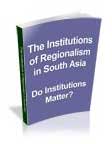 The Institutions of Regionalism in South Asia - Do Institutions Matter?This paper assesses the contribution of key institutions of regional cooperation and integration (RCI) in South Asia, and suggests ways in which the Asian Development Bank and other development partners can strengthen their support. It attempts to enhance understanding on the interplay between politics and RCI, including how good bilateral political relations or improvements have advanced RCI. With the overall political environment growing increasingly open to RCI, the paper suggests the time has come for the South Asian Association for Regional Cooperation (SAARC) to consider strengthening the capacity of the SAARC Secretariat to meet the growing challenges and work load of managing the anticipated increase in RCI. Author: Prabhu Ghate Year: 2011 Download Tags: Regional Cooperation, Regional Integration, Development, SAARC, Trade, Services, Trade Facilitation, Energy, Free Trade Agreements, SAFTA, Bangladesh, Bhutan, India, Maldives, Nepal, Sri Lanka, Transport The Provision of Regional Public Goods in South AsiaThis report reviews the provision of high priority regional public goods (RPGs) selected
for the South Asia subregion, and proposes areas of cooperation for improving the provisioning of RPGs in South Asia. It highlights the issues in cross border management of infrastructure projects and best practices in the provisioning of RPGs relevant for South Asia, evaluates ADB’s contributions to providing RPGs in the subregion, and concludes with recommendations on ADB’s South Asia Regional Department’s role in the provision of RPGs in the subregion. Author: Khaja Moinuddin Year: 2010 Download Tags: Energy, Agriculture, Disaster Risk, Governance, Poverty Reduction, Bangladesh, Bhutan, India, Maldives, Nepal, Sri Lanka, Trade Facilitation, Transport Binding Contraints to Regional Cooperation and Integration in South AsiaThis paper examines the benefits of regional cooperation and integration, focusing on the cost of neglecting to address the binding constraints to regional cooperation and integration. Component papers in this volume analyze the current state of play, and identifies the binding constraints to achieving more efficient transport corridors, regional energy trade and trade facilitation in the region. Author: Gilberto M. Llanto Year: 2010 Download Tags: Regional Cooperation, Economic Integration, Trade Facilitation, Energy, Bangladesh, Bhutan, India, Maldives, Nepal, Sri Lanka, Transport Infrastructure for a Seamless AsiaThe study reviews regional infrastructure being enhanced through regional cooperation in Asia and examines major issues and challenges. It suggests a framework for pan-Asian infrastructure cooperation, anchored on a long-term vision of creating a seamless Asia that will not only enhance the region's competitiveness and extend its global reach, but also help reduce poverty and promote greater environmental sustainability. Author: Asian Development Bank / Asian Development Bank Institute Year: 2009 Download Tags: Regional Cooperation, Regional Integration, Transport, Trade Facilitation, Connectivity, India, Bangladesh, Bhutan, Nepal, Maldives, Sri Lanka, Asian Highway, Trans-Asian Railway Network, Energy, Myanmar Pan-Asian IntegrationIn today's globalized world where the economic fates of nations are inevitably linked, weathering the present economic storm for Asia will increasingly depend on harnessing regional dynamics particularly on the trade front. Pan-Asian Integration: Linking East and South Asia is a rich volume of perspectives from leading thematic experts on regional patterns of trade and investment, trade-related infrastructure, trade facilitation, among others. Author: Asian Development Bank Year: 2009 Download Tags: Regional Cooperation, Regional Integration, Trade Policy, Transport, Trade Facilitation, Economics, India, Free Trade Agreements 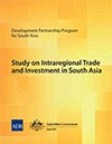 Study on Intraregional Trade and Investment in South AsiaThis study broadens and deepens intraregional cooperation and integration in trade and investment among South Asian countries. It showcases the benefits of regional integration and presents an array of policy recommendations to maximize and realize such gains. Three parallel initiatives are needed: first, reduce nontariff barriers to deepen the South Asian Free Trade Area (SAFTA); second, expand SAFTA's scope to include investments and services; and third, focus on key industries to succinctly demonstrate the process and benefits of reforms. These translate into six component studies: (i) the Role of Trade Facilitation in South Asian Economic Integration; (ii) Country Investment Studies for Bangladesh, India, Nepal, and Sri Lanka; and (iii) Textile and Clothing Industry. The study invigorates the debate and focus on South Asian integration as a means to further growth and reduce poverty. Author: Asian Development Bank / Australian Government Year: 2009 Download Tags: Trade Policy, Trade Facilitation, Regional Cooperation, Regional Integration, Bangladesh, India, Nepal, Sri Lanka, SAFTA Quantification of Benefits from Economic Cooperation in South AsiaThe study examines the implication of the South Asian Free Trade Agreement (SAFTA) on South Asian countries and on the region as a whole, employing both a quantitative and qualitative assessment on the outcomes of SAFTA. The research aims to provide support in the formulation of concrete policy measures for trade to ensure greater gains for the region, while at the same time mitigating potential negative impacts. Economic and social assessments through analytical tools and rational causal chain analysis further enrich the study. Author: Asian Development Bank / United Nations Conference on Trade and Development Year: 2008 Download Tags: Economic Corridor, Regional Cooperation, Regional Integration, SAFTA, Free Trade Agreements, Trade Facilitation, Transport, Services, SAARC, Bangladesh, Bhutan, India, Maldives, Nepal, Sri Lanka |



